The Toyota LandCruiser is one of the world’s most renowned 4WDs, owing to its reputation for reliability and off-road capability.
There’s a reason you’ll find Land Cruisers living in sub-Saharan Africa, or deep in the Australian outback. Their owners know that a Land Cruiser will rarely let them down. Naturally, the stakes are going to be high when Toyota decides to release a new generation of the Land Cruiser, given the weight of the nameplate and the expectations of the buyer.
After 14 years of the well-loved 200 series Land Cruiser, Toyota decided to start fresh in 2021, with the introduction of the Land Cruiser 300. The hotly anticipated 300 series wasn’t without controversy, having ditched the 200’s powerhouse V8 in favour of a twin-turbo diesel V6.
I cannot recall any SUV that’s generated as much interest as the new Land Cruiser 300. So, when DriveLife was offered the keys to a Land Cruiser 300 GR Sport, we figured an afternoon on Wellington’s south coast was in order.
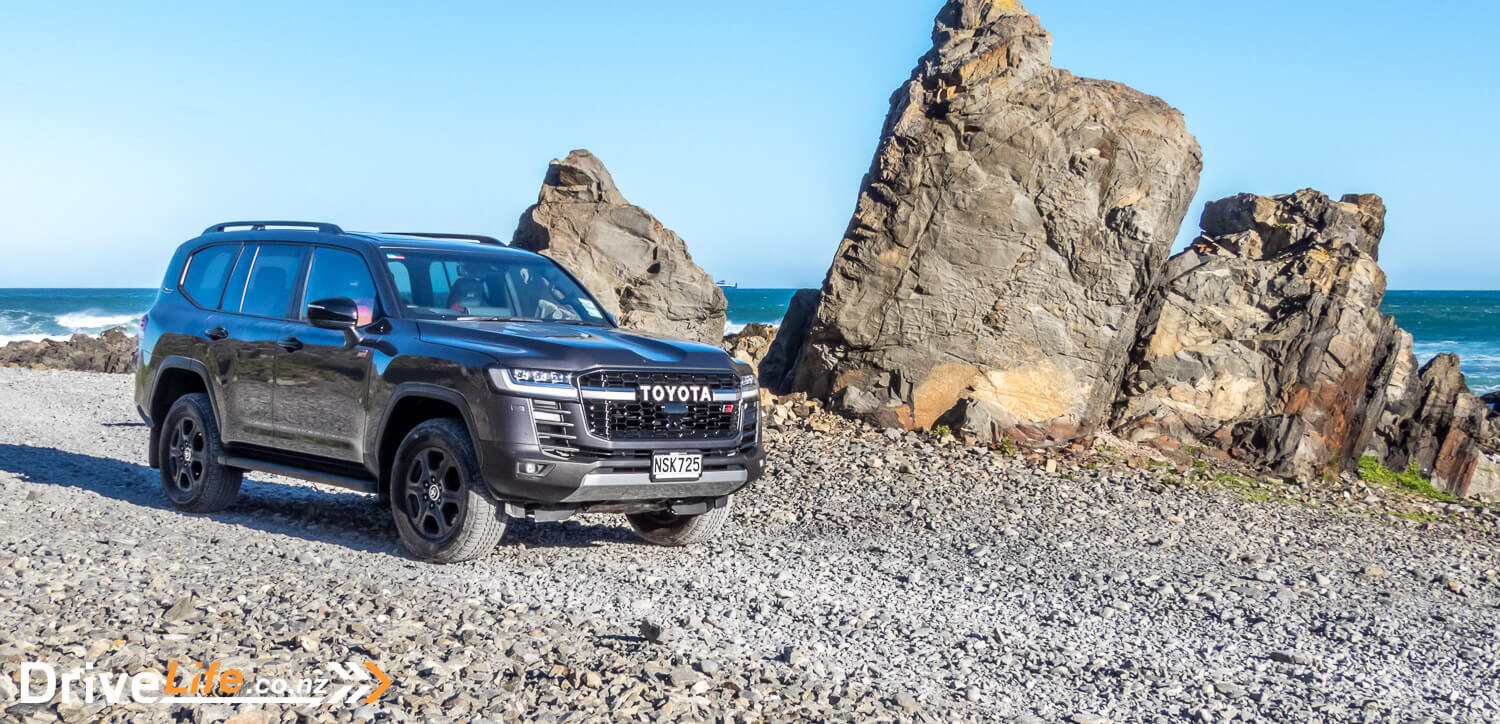
What We Like and Dislike About The 2022 Toyota Land Cruiser 300 GR Sport
| What we like | What we don’t like |
| Off-road capability Wafts of torque V6 engine refinement Excellent 10-speed auto Driving position Ride quality Hypothetical reliability | Expensive No more split tailgate Infotainment software needs work Door bins don’t fit large water bottles Sensitive safety equipment … and good luck finding one |
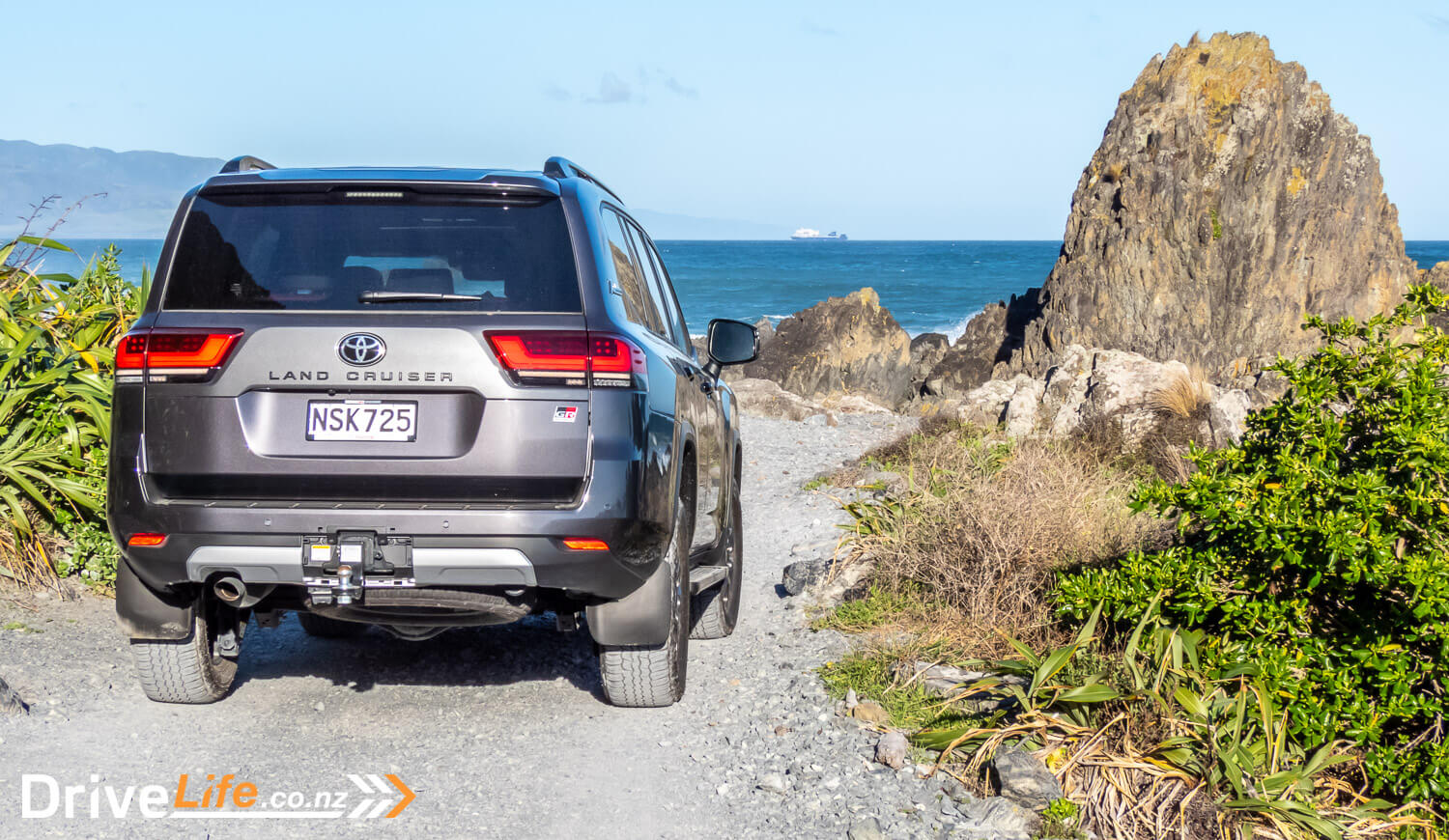
The Toyota Land Cruiser 300 is offered in three different models, with prices starting at $127,990.
| Model | Price |
| Land Cruiser 300 VX | $127,990 |
| Land Cruiser 300 VX Limited | $141,990 |
| Land Cruiser 300 GR Sport | $147,990 |
The entry level model is the Land Cruiser 300 VX. Next in the range is the VX Limited, which is the ‘nice’ Land Cruiser, with all the interior toys. At the top of the range is the Land Cruiser 300 GR Sport, for those that find themselves spending more time off-the-road, rather than on it.
This is also indirectly told by the fact that the VX and VX limited offer seating for seven, whereas the GR Sport is only a five-seater.
All New Zealand models of the Land Cruiser 300 are powered by a 3.3-litre twin-turbo V6 diesel producing 227kW of power and 700Nm of torque.
2022 Toyota Land Cruiser 300 Standard Equipment Highlights
As standard for the Land Cruiser range, you receive:
- 18’’ alloys
- 12.3’’ infotainment with Bluetooth, Sat-nav and SUNA Traffic Control
- 7″ instrument cluster information display
- Apple Carplay and Android Auto
- 10-speaker audio system
- 10 airbags
- Reversing Camera, with Panoramic View Monitor
- 10-way powered driver Seat
- 8-way power front passenger Seat
- Heated and Ventilated front seats
- Four Zone Climate Control
- Wireless charger
- Head-up Display (HUD)
- Smart Entry and Push Button Start
- Auto Dimming Rear-view Mirror
- Powered and heated door mirrors
- Front and rear parking sensors
- 2 ISOFIX points
- Rear Privacy Glass
- Roof-rails
- Alloy Side Steps
- Automatic Projector LED Headlights, with LED Daytime Running Lights and Fog lights
- Automatic High Beam
- Rain sensing wipers
- Multi-terrain select (off-road drive modes)
- Multi-terrain monitor (front, side and underfloor cameras)
- Dynamic Radar Cruise Control, with Linked Indicator Control
- CRAWL Control
Upgrading to the VX Limited, you get:
- 20’’ alloys
- 14-speaker JBL audio system
- Three memory settings front seats
- Heated and Ventilated 2nd row seats
- Centre Cool box
- Powered tailgate
- Sunroof
- Chrome door handles and side mirror surrounds
- 2x 11.6’’ rear touchscreen entertainment screens with WIFI and HDMI input
Opt for the GR Sport, and you’ll receive:
- 18” matte grey alloys
- 14-speaker JBL audio system
- Three memory settings front seats
- Centre Cool box
- Powered tailgate
- Sunroof
- Heated and Ventilated 2nd row seats
- Adaptive Variable Suspension
- Adaptive high beams
- E-KDSS (Electronic-Kinetic Dynamic Suspension System)
- Front and rear locking differentials
- Six drive modes including Sport S, Sport S+, Customise and Comfort
- Gazoo Racing interior and exterior detailing, which includes Black Wheel Arches, Gloss Black Door Handles and mirror surrounds, Matte Black Lower Back Door Decal, Black Lower Bumper & Gloss Black Mesh Grille
Every Land Cruiser is fully equipped with Toyota’s Safety Sense package, giving each Land Cruiser the following:
- Road Sign Assist
- Lane Tracing Assist with Lane Departure Warning, and Yaw Assist
- Pre-Collision System with Autonomous Emergency Braking, Pedestrian and Cyclist Detection, Intersection Turn Assist and Emergency Steering Assist
- Blind Spot Monitoring
- Active Traction Control
- Down-hill Assist Control
- Emergency Stop Signal
- Hill-start Assist Control
- Rear Cross Traffic Alert
- Trailer Sway Control
- Tyre Pressure Monitor
- Vehicle Stability Control
The Land Cruiser 300 VX and VX Limited are offered with eight different colour options, being:
- Crystal Pearl (White)
- Silver Pearl
- Graphite (Deep Grey)
- Ebony (Gloss Black)
- Eclipse (Matte Black)
- Merlot Red (Burgundy)
- Avant-Garde Bronze (Beige)
- Deep-Sea Blue.
The VX Limited also has two interior colour choices, being Black and Sandstone.
The Land Cruiser 300 GR Sport is offered with five different colour options, these are:
- Arctic White
- Graphite (Deep Grey)
- Ebony (Gloss Black)
- Eclipse (Matte Black)
- Merlot Red (Burgundy).
There are two interior trim options, being Black and Red/Black combination.
For more information on the Land Cruiser 300, check out the Toyota New Zealand website
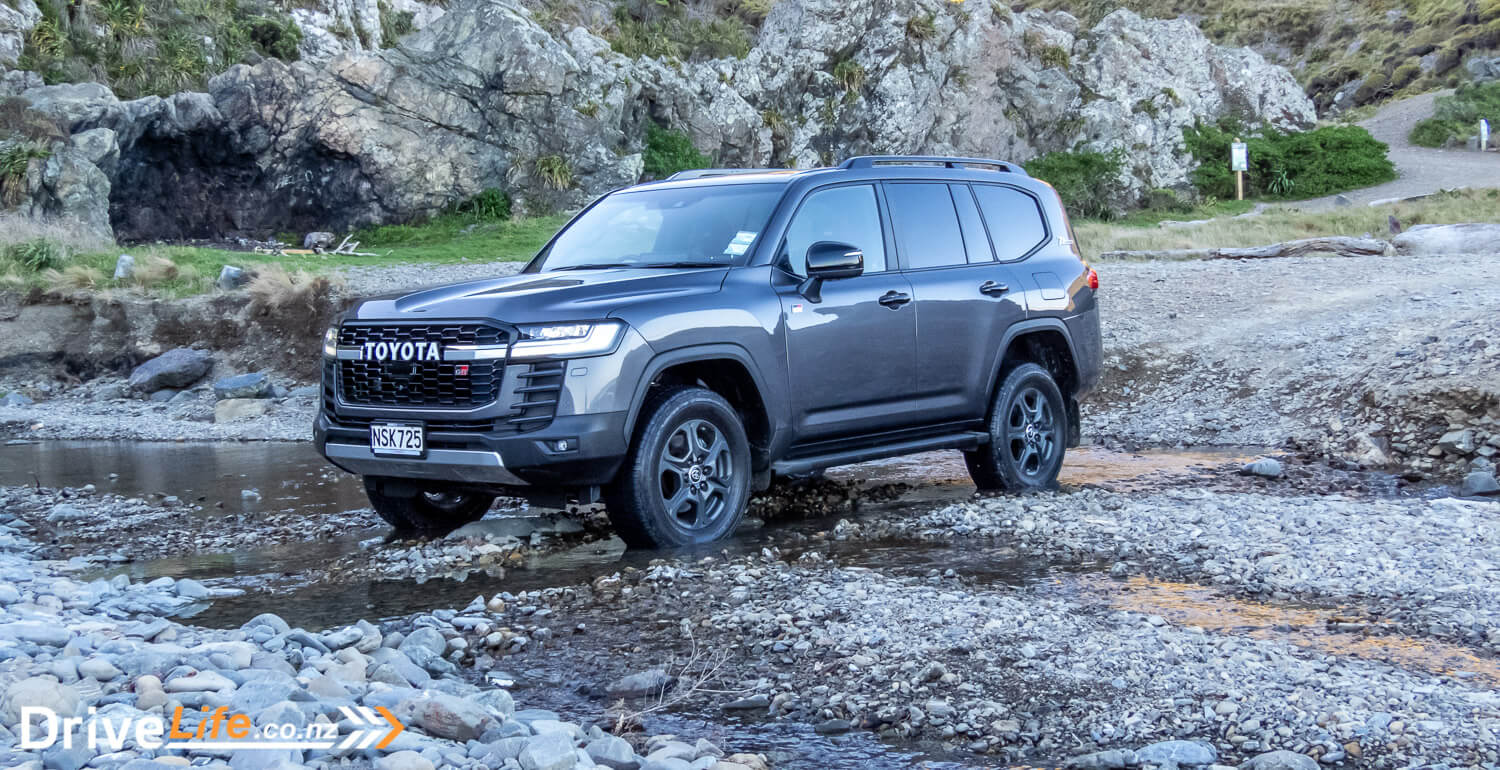
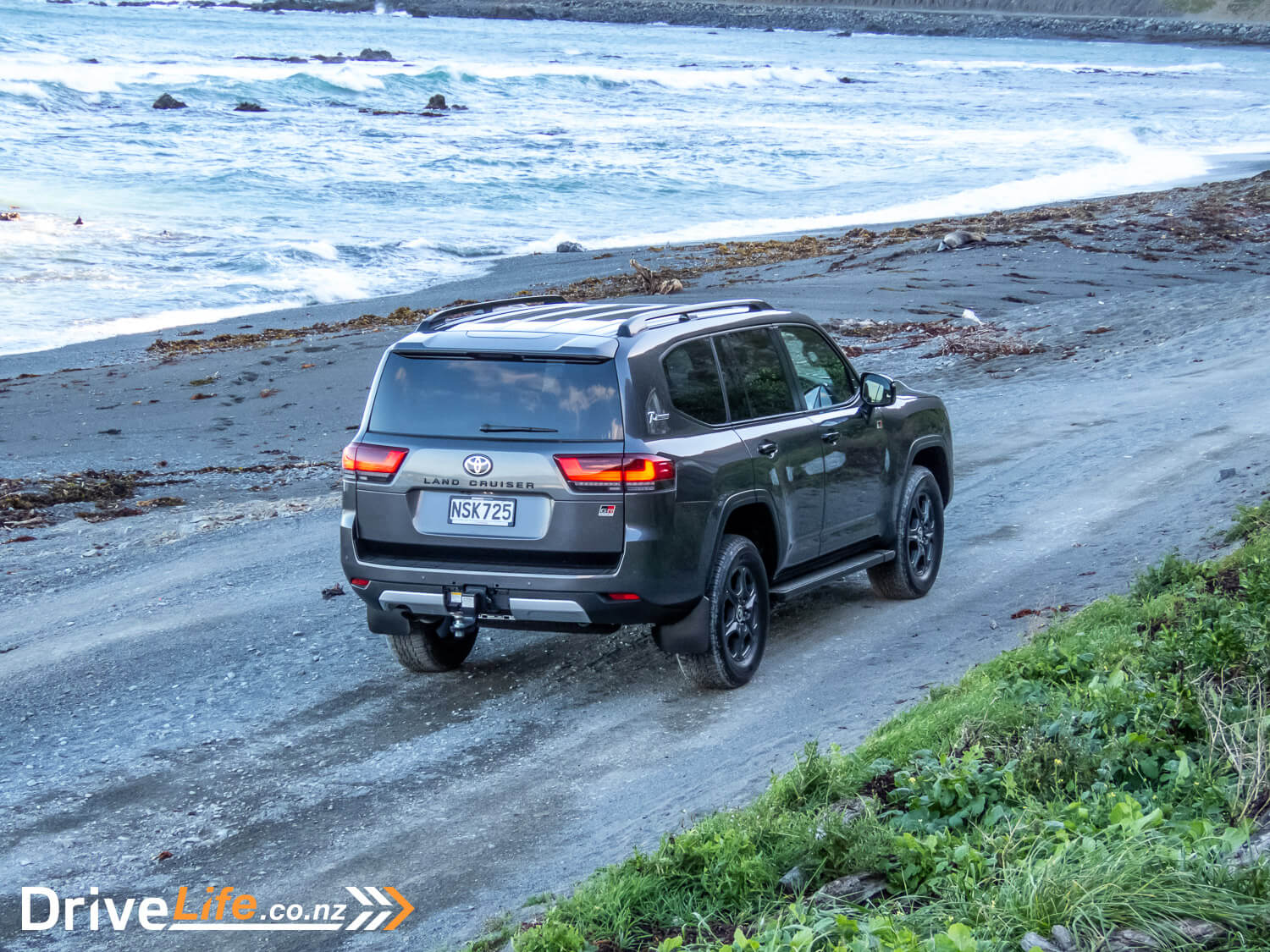
How Does The 2022 Toyota Land Cruiser 300 GR Sport Compare To Its Competition?
We’re incredibly lucky to get the Land Cruiser 300 in New Zealand. Many markets, including the United States and the United Kingdom, will not get the Land Cruiser 300 in their dealerships.
The Land Cruiser 300 has strong competition in the large SUV category. While the Land Rovers might match the Land Cruiser’s off-road ability, few of these SUVs can hold a candle to the Land Cruiser’s legendary toughness and hypothetical reliability.
Getting your hands on a Land Cruiser 300 might require some patience. As of April 2022, there’s a 12-month wait for any Land Cruiser 300 model in New Zealand. Toyota New Zealand is doing their best to move it along, but with even longer wait times in markets overseas, bank on waiting the full 12-months.
| Make/ Model | Engine | Power/Torque kW/Nm | Seats | Fuel L/100km | Towing Capacity | Boot Space, litres | Price |
| Mercedes GLS 400d | 3.0-litre, 6-cylinder turbo-diesel | 243/700 | 7 | 7.7 | 750/3400 | 1320 | $177,700 |
| Audi Q7 50 TDI S-Line | 3.0L turbo-diesel V6 | 210/600 | 8.1 | 750/3500 | 865 | $150,990 | |
| Land Rover Discovery R Dynamic HSE | 3.0L turbo-diesel V6 | 221/650 | 7 | 8.8 | 750/3500 | 922 | $148,900 |
| Toyota Land Cruiser 300 GR Sport | 3.3L twin-turbo diesel V6 | 227/700 | 5 | 10.2 | 750/3500 | 1004 | $147,990 |
| Land Rover Defender 110 HSE | 3.0 litre 6-cylinder, turbocharged petrol MHEV | 294/550 | 7 | 9.9 | 750/3500 | 786 | $145,990 |
| Volkswagen Touareg R-Line | 3.0L turbo-diesel V6 | 210/600 | 5 | 8.2 | 750/3500 | 810 | $126,490 |
| Volvo XC90 R Design | 2.0 I4 common-rail twin-turbo diesel | 173/480 | 7 | 8.2 | n/a/2700 | 709 | $111,900 |
| Nissan Patrol TI-L | 5.6L V8 petrol | 298/560 | 7 | 14.4 | 750/3500 | 1413 | $108,990 |
| Jeep Grand Cherokee Overland | 3.0L turbo-diesel V6 | 184/570 | 5 | 7 | 750/3500 | $104,990 |
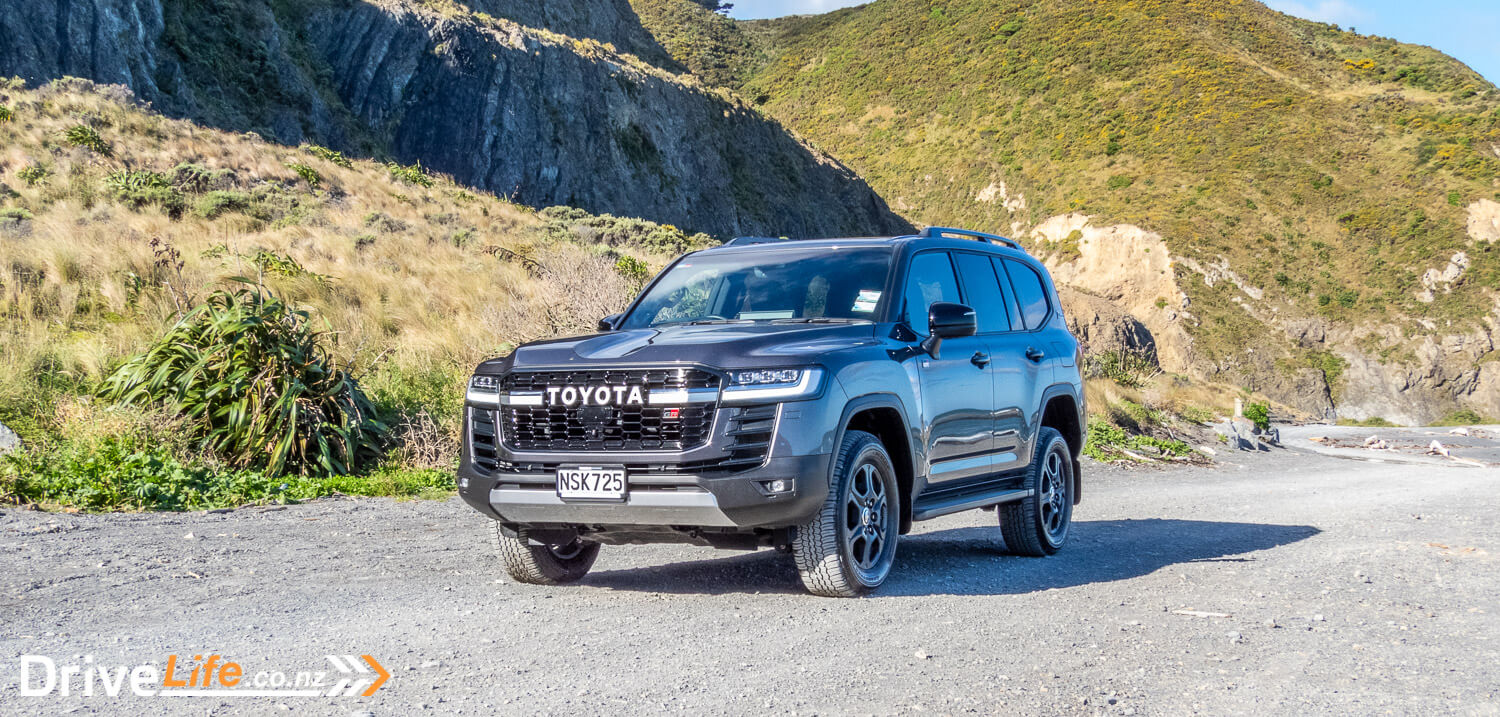
First Impressions Of The 2022 Toyota Land Cruiser 300 GR Sport
It wouldn’t be a Land Cruiser if it weren’t big, imposing and purposeful. The 300 series is no exception.
Truth be told, I was on the fence when I first saw images of the new Land Cruiser 300. The indicator and DRL housing being larger than the headlights gave the Land Cruiser an odd look. As is usually the case, the Land Cruiser looks much nicer in the flesh relative to photos.
It’s remarkable how a grille, a few bumpers and some wheels can change your perception of a vehicle. The GR Sport looks like a purposeful off-roader, whereas the large chrome grille on the VX and VX Limited make it seem more school-run friendly.
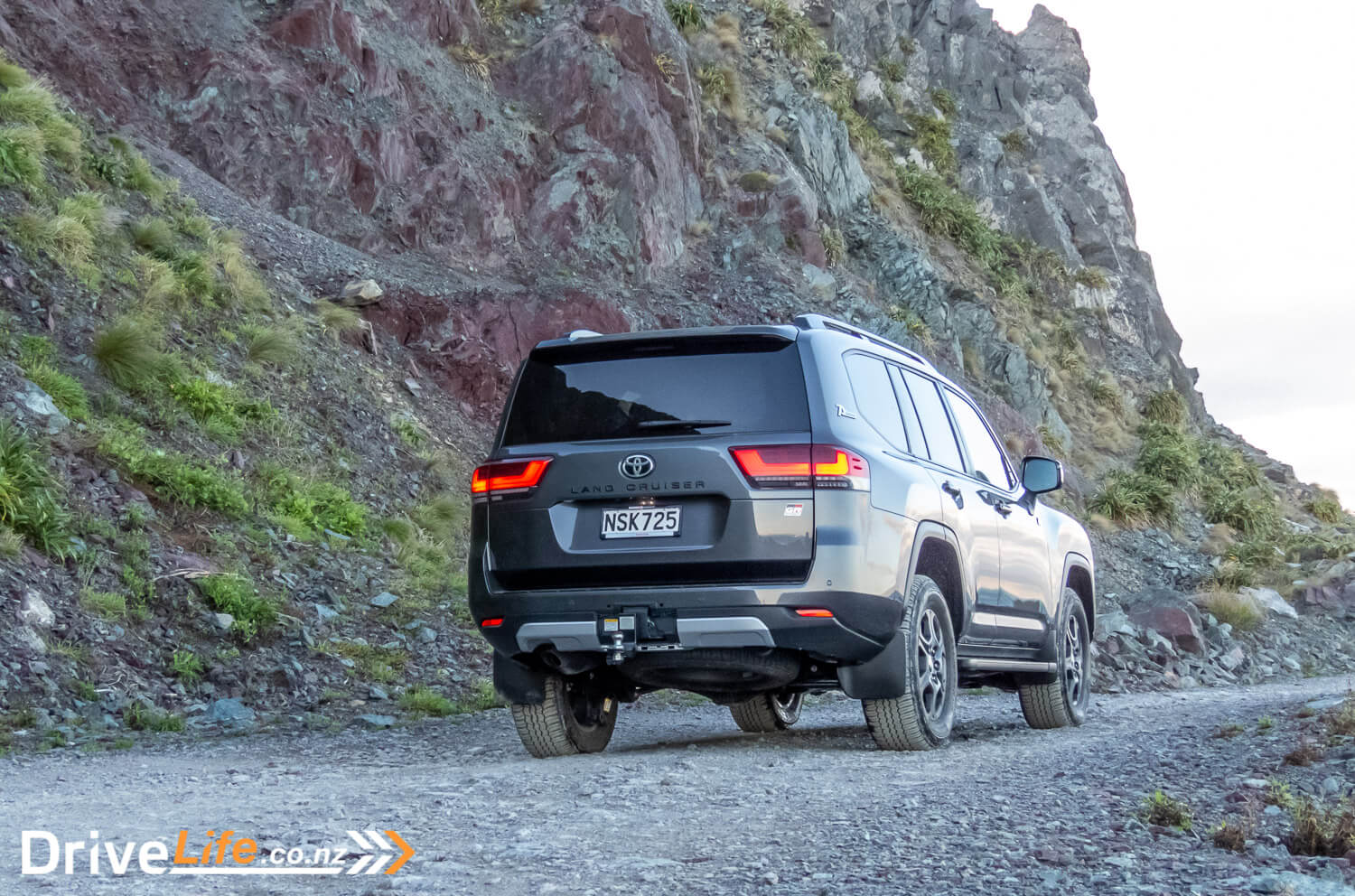
What’s The Interior Like In The 2022 Toyota Land Cruiser 300 GR Sport?
The Land Cruiser’s reputation for being indestructible naturally lends itself to the interior. What good is it if the engine continues to run if the interior has fallen to bits?
The build quality is immediately evident upon climbing inside the cabin. The usual Toyota sturdiness is there, but also there’s a generous use of leather and high-quality plastics. It feels like an expensive interior, not so much in a luxurious manner, but in a well-engineered way.
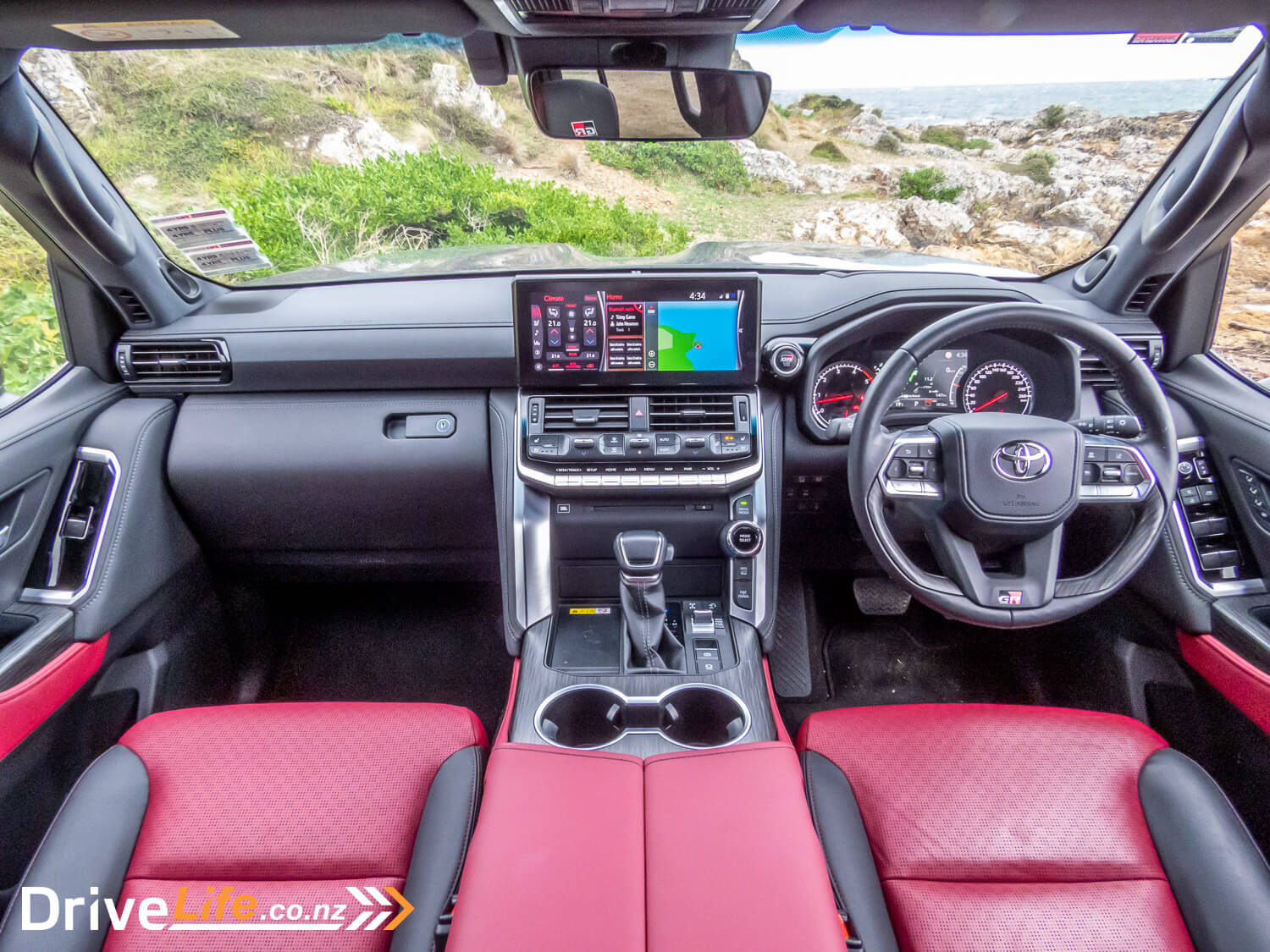
Inside, there’s a comfortable blend of old and new. Sitting proudly atop the dashboard is a 12.3’’ infotainment unit, which is connected up to a 14-speaker JBL audio system. Beneath are extra-large physical buttons and switches for the climate controls, plus the heated/ventilated seats. Framing the outside of climate controls are metallic-textured, hard buttons for the infotainment. Although extra-large physical controls can clutter an interior, they’re designed to be easily operated with gloves on.
Moving down the centre console, you’ll find controls for the high/low range, crawl control, and a large drive mode selector dial on the right bezel. Toyota’s also chucked in a CD player for good measure.
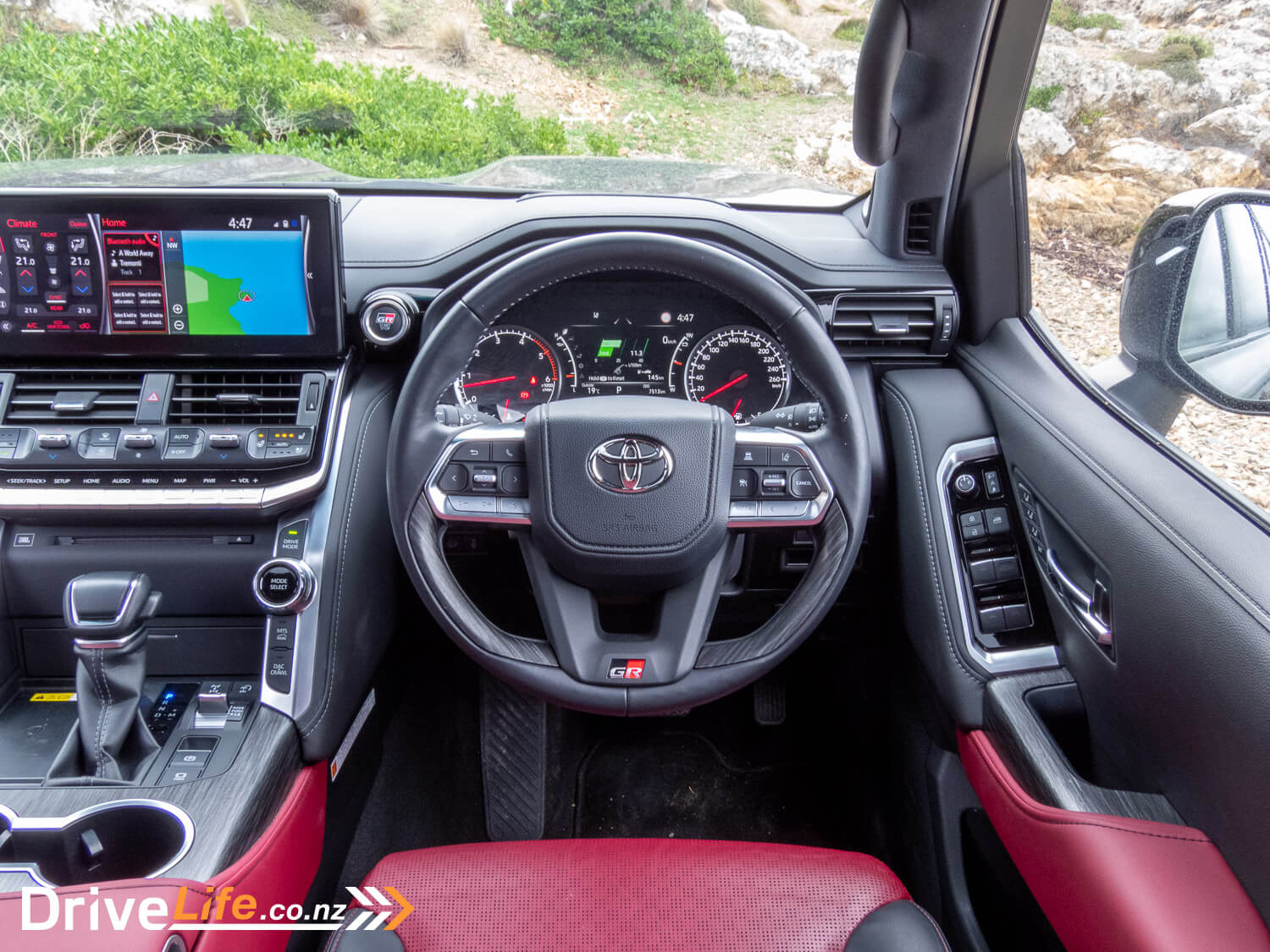
Next to the gear stick is a wireless phone charger, which my Samsung S10+ would fully occupy. Hopefully, mobile devices don’t continue to increase in size.
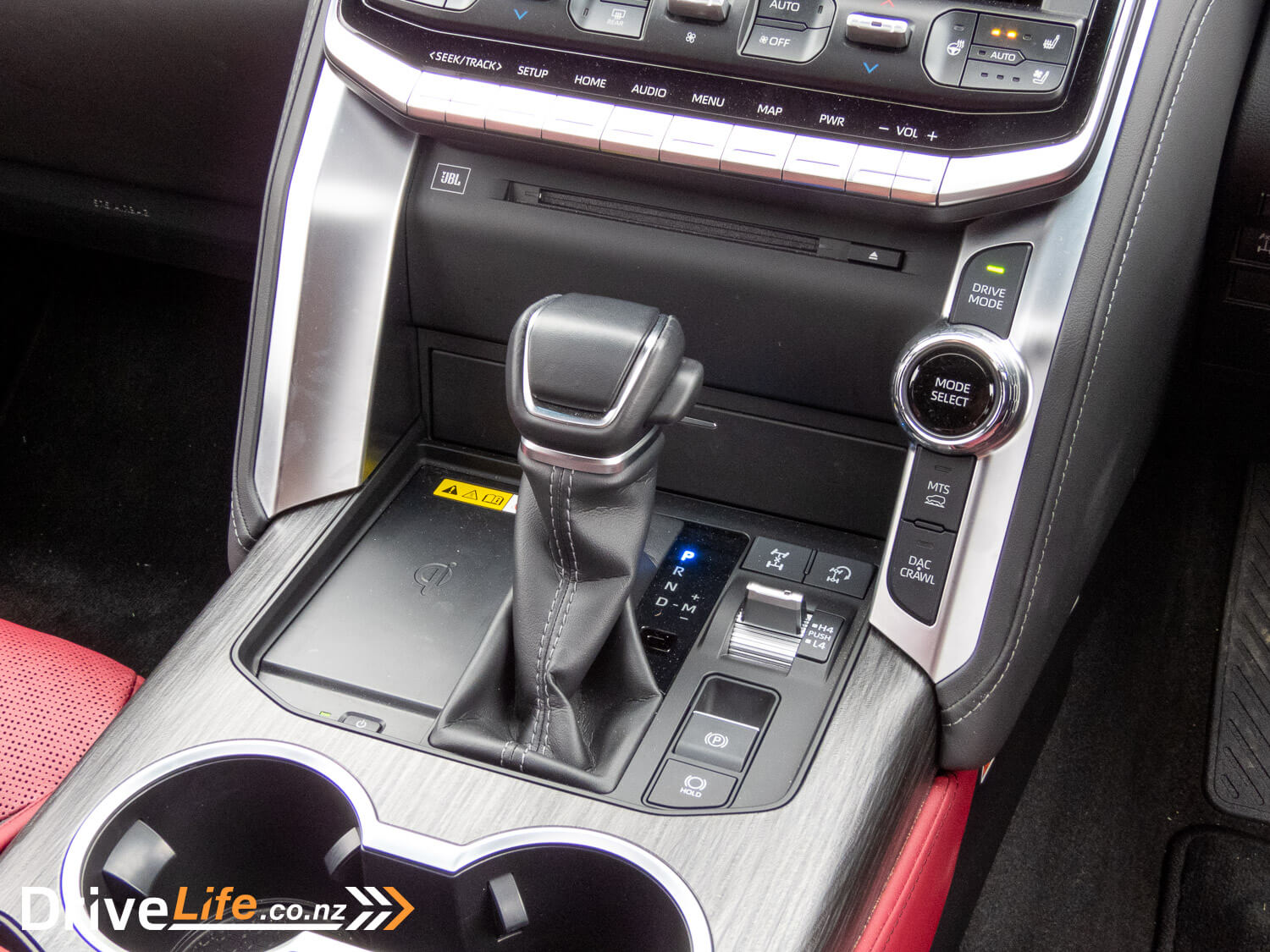
The best part of the Land Cruiser’s interior is its driving position. From the front seats, you have a true captain’s-chair feeling. You’re perched high in the cabin, with a commanding view outside over the double grooved bonnet. The door sills are low and the centre armrest is mounted high, giving you an optimal armrest height either side. You feel like a king as you stare down into the timid eyes of the Ford Ranger driver next to you.
The front seats themselves are also excellent. The seats are heated and ventilated and the driver can dial in a comfortable amount of lumbar support. The seats also fit wide, meaning the Land Cruiser isn’t going to be judgemental of your lunch choices.
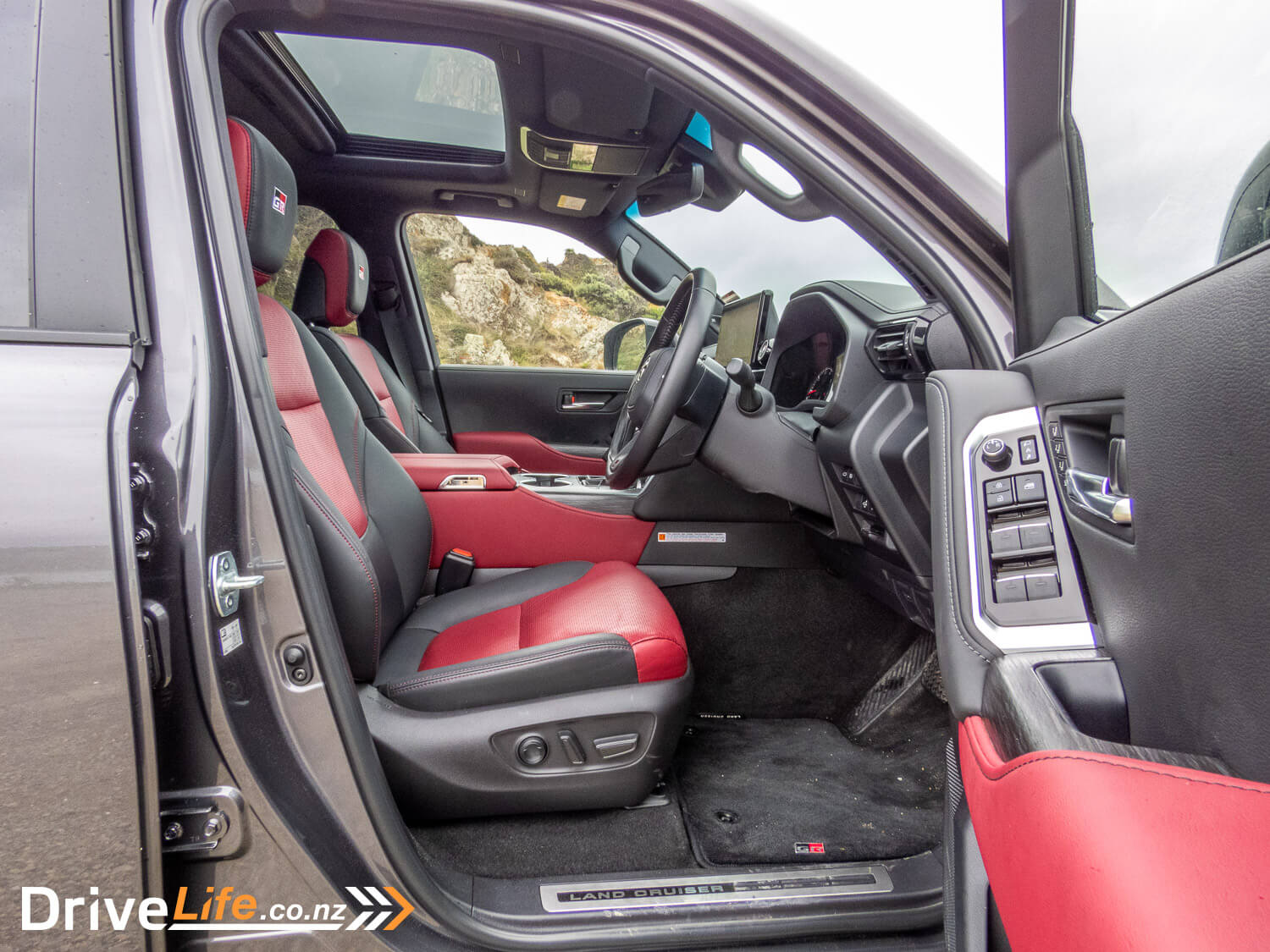
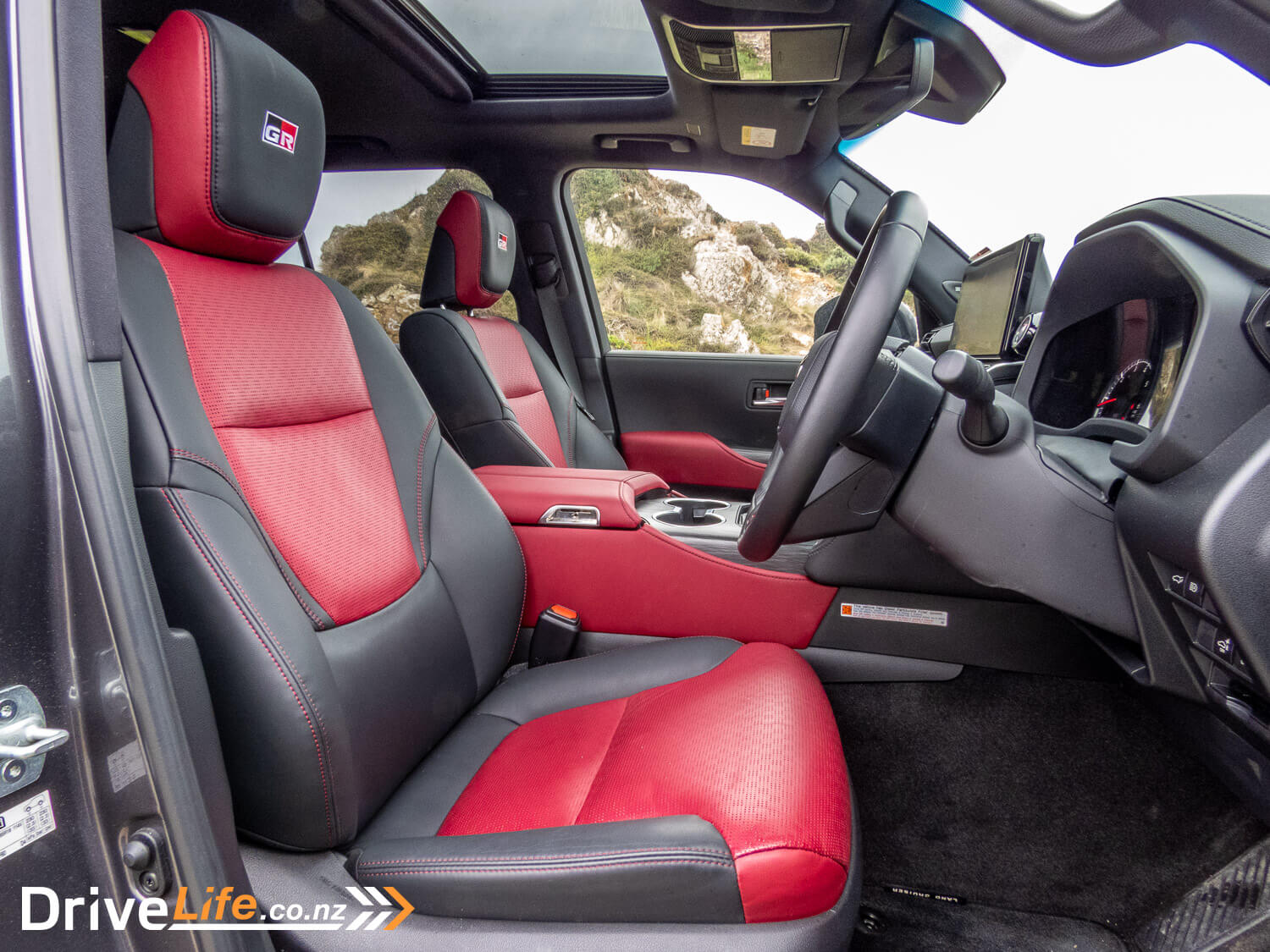
The Land Cruiser’s design as a body-on-frame SUV becomes apparent climbing into the second row. In the back, the floor is high relative to your seating position, meaning I wasn’t able to sink down enough in the seats to get complete under thigh support. This aside, rear passengers have ample head and legroom, plus rear passengers get two-zone climate control plus heated and ventilated seats for the outboard passengers.
Around the back of the Land Cruiser, the Land Cruiser’s seven-seat lineage remains obvious. There’s still third row cup holders despite the GR Sport only being a five-seater. I suppose you could throw a few loose tools in there instead. There’s also a household plug socket in the boot too. Being a five-seater, you get a cavernous boot space, offering 1,131L with the seats up, or 2,052L with the seats down.
However, the Land Cruiser’s biggest omission is the loss of the split tailgate, which featured on the last generation Land Cruiser 200. Instead, the 300 gets a single-piece powered tailgate. Enthusiasts have already been vocal with their dissatisfaction over this choice, and I’m united with them on this one. Split tailgates are cool – c’mon Toyota.
Surprisingly, storage isn’t a strong point of the 300 series’ interior. The water-bottle holders in the door cards struggle to fit anything larger than a 600ML Coke bottle. The central cupholders have a false floor on one side, meaning you can fit in a large bottle. Unfortunately, the front passenger can’t do the same on their side.
Inside the centre console, Toyota options the GR Sport with a Cool Box, which pumps cold air into the insulated compartment. It’s handy if you’ve got drinks to keep cold, otherwise, all the plastic insulation means the storage isn’t as large as its double-hinged lid would imply.
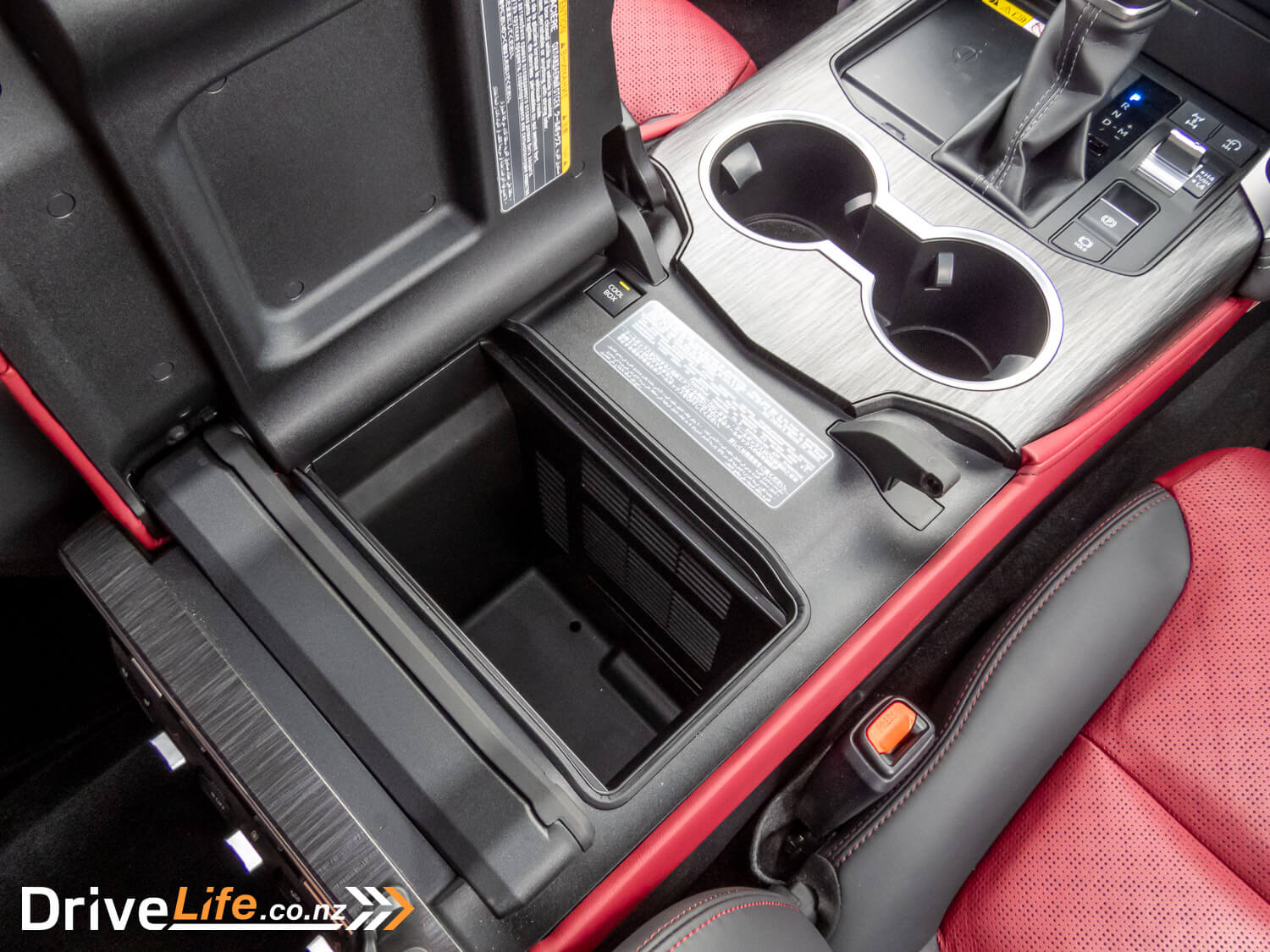
Shifting focus to the infotainment unit, the interface is partitioned into two screens, on a 70/30 split. The split-screen software is initially a tad awkward to use, but you’ll quickly pick it up.
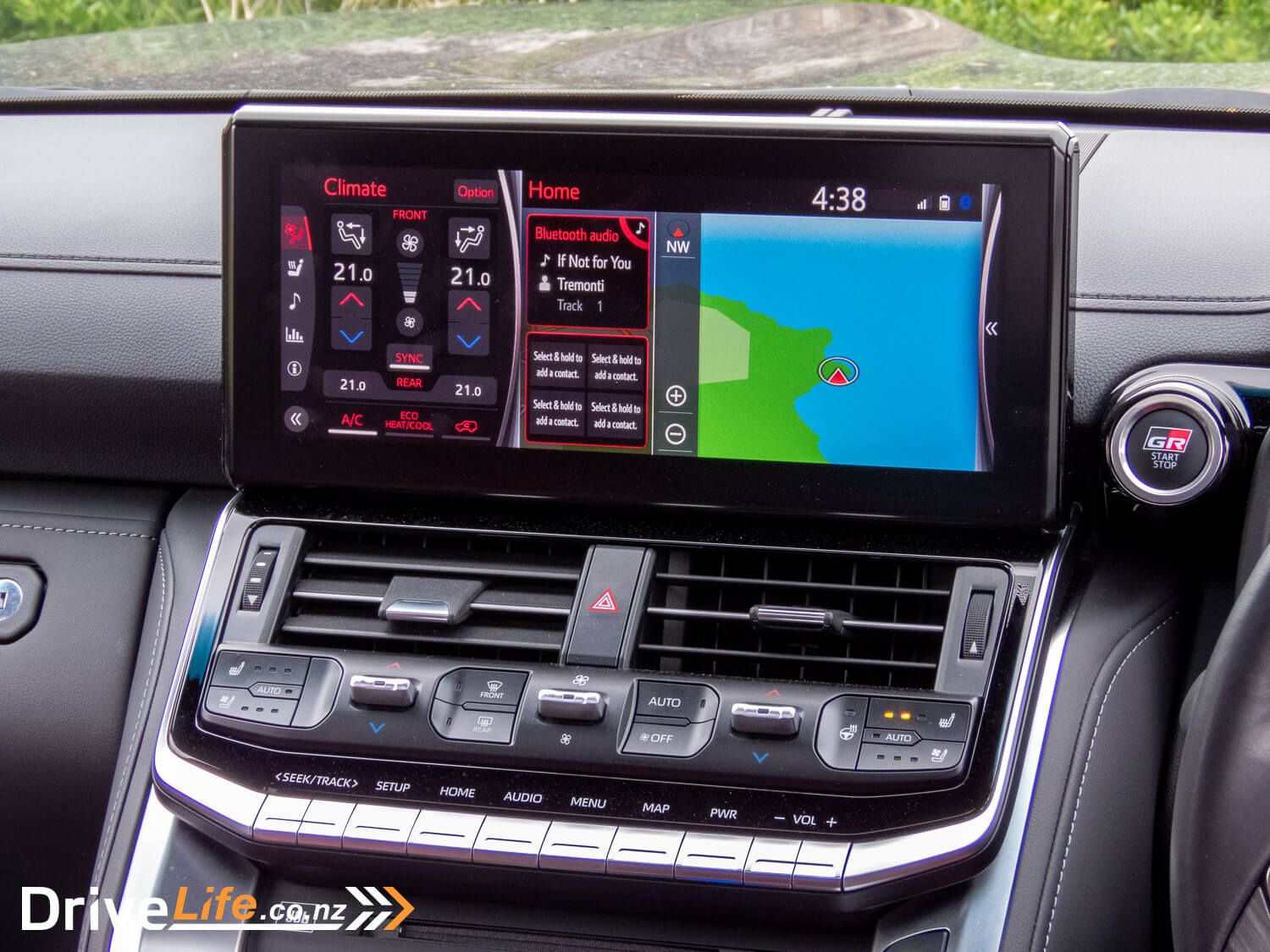
On the larger side, Toyota runs their usual infotainment software. I’ve previously criticised Toyota’s infotainment software for being dated, and unfortunately, the system has been copied directly into the Land Cruiser. It’s not a terrible system on its own, but it’s well behind the quality of the competition.
The main complaints are that the system is slow-to-respond and the SatNav is frustratingly difficult to use. Otherwise, the screen resolution is excellent, the interface is simple to navigate and core functions work well.
The smaller side is a multi-information display, which is there to support the climate control functions. The small screen displays the air temperature and has the soft controls for air recirculation (there’s no hard button for this). The screen also duplicates the physical climate controls, but this is redundant in my view. Alternatively, the screen can also display music streaming and vehicle data, such as fuel consumption.
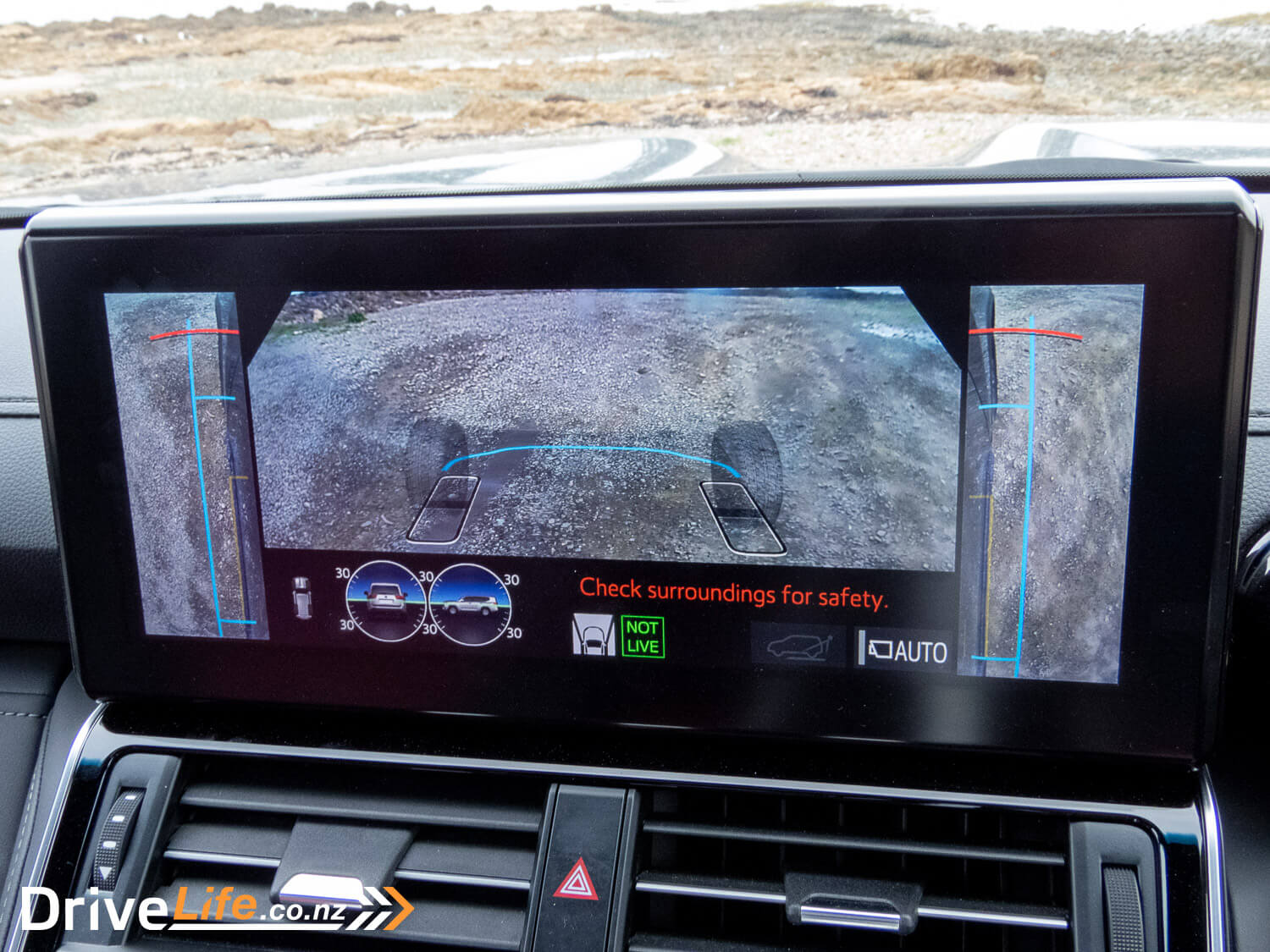
Despite the flaws, the Land Cruiser’s infotainment does have a trick or two up its sleeve. It’s rigged up to a series of cameras, which display frontal, side, underside, top-down and 360-degree views. These cameras all have decent image clarity, and proved more than handy during our expedition around the south coast.
The infotainment is paired with a 14-speaker JBL audio system. It’s one thing to have brand name speakers, but it being engineered to sound good is another. Fortunately, Toyota has balanced this audio system nicely.
The instrument cluster is clearly legible and the digital aspects are clear, and easy to use. Toyota’s heads-up display shows plenty of information, without being distracting. Other manufacturers could also learn something from Toyota’s simple steering wheel controls – it’s great to use.
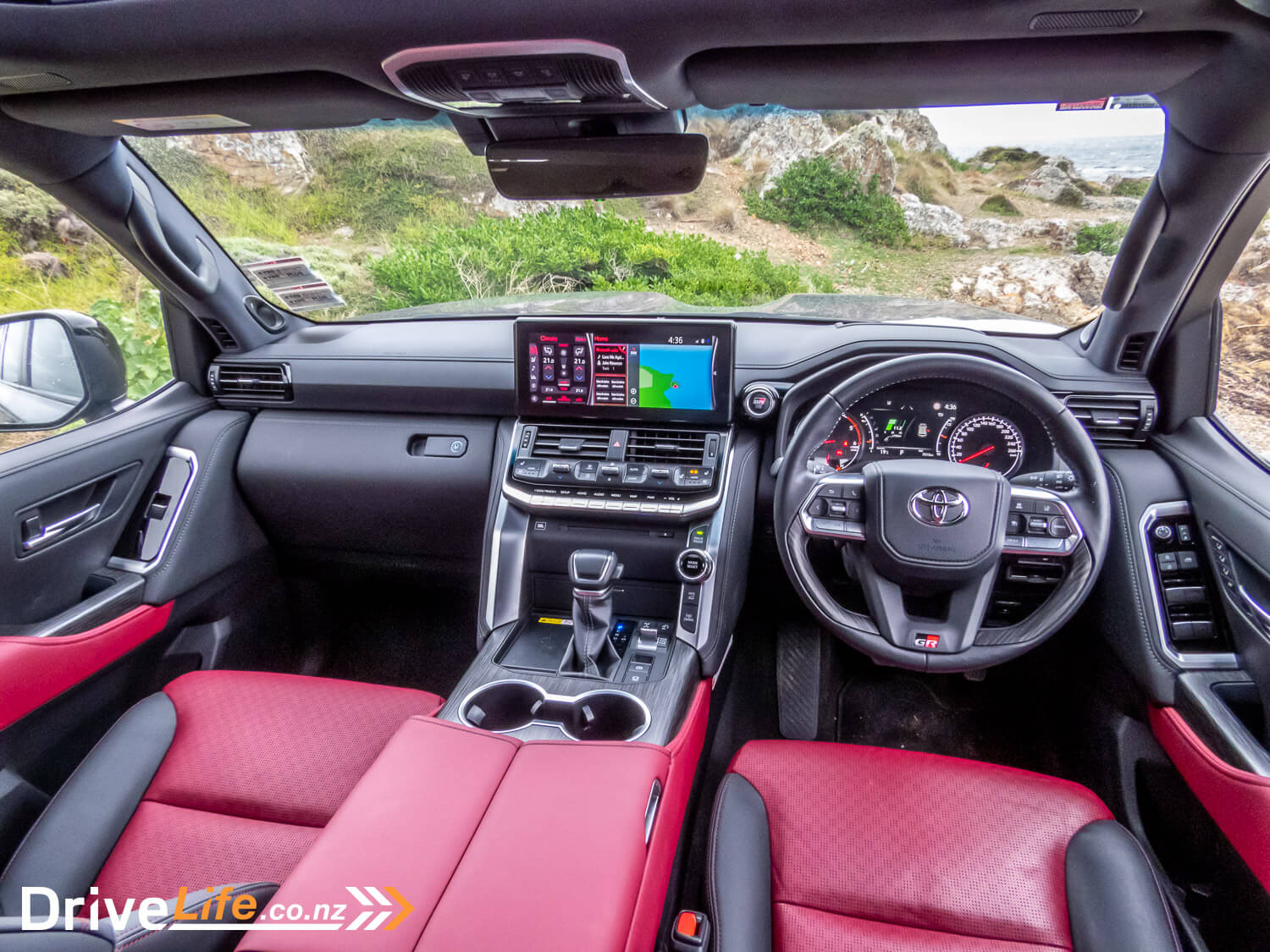
What’s The 2022 Toyota Land Cruiser 300 GR Sport Like To Drive?
Toyota’s engineers must have been under extreme pressure during the development of the Land Cruiser 300. Any change was going to be closely scrutinised by Land Cruiser loyalists. I can almost imagine the hours of sleep forgone, to ensure that the 300 series didn’t fudge anything up.
Convincing buyers that the new 3.3L V6 twin-turbo diesel engine was going to be just as good, if not better than the outgoing V8, was going to be a tall order. As much as we loved the V8 in the 200 series, Toyota’s move to downsize is hardly surprising. We live in an era of increasing emissions regulations and rising fuel prices.
That said, used Land Cruiser 200 prices have remained stronger than ever as at the time of writing, which goes to show how revered these cars are.
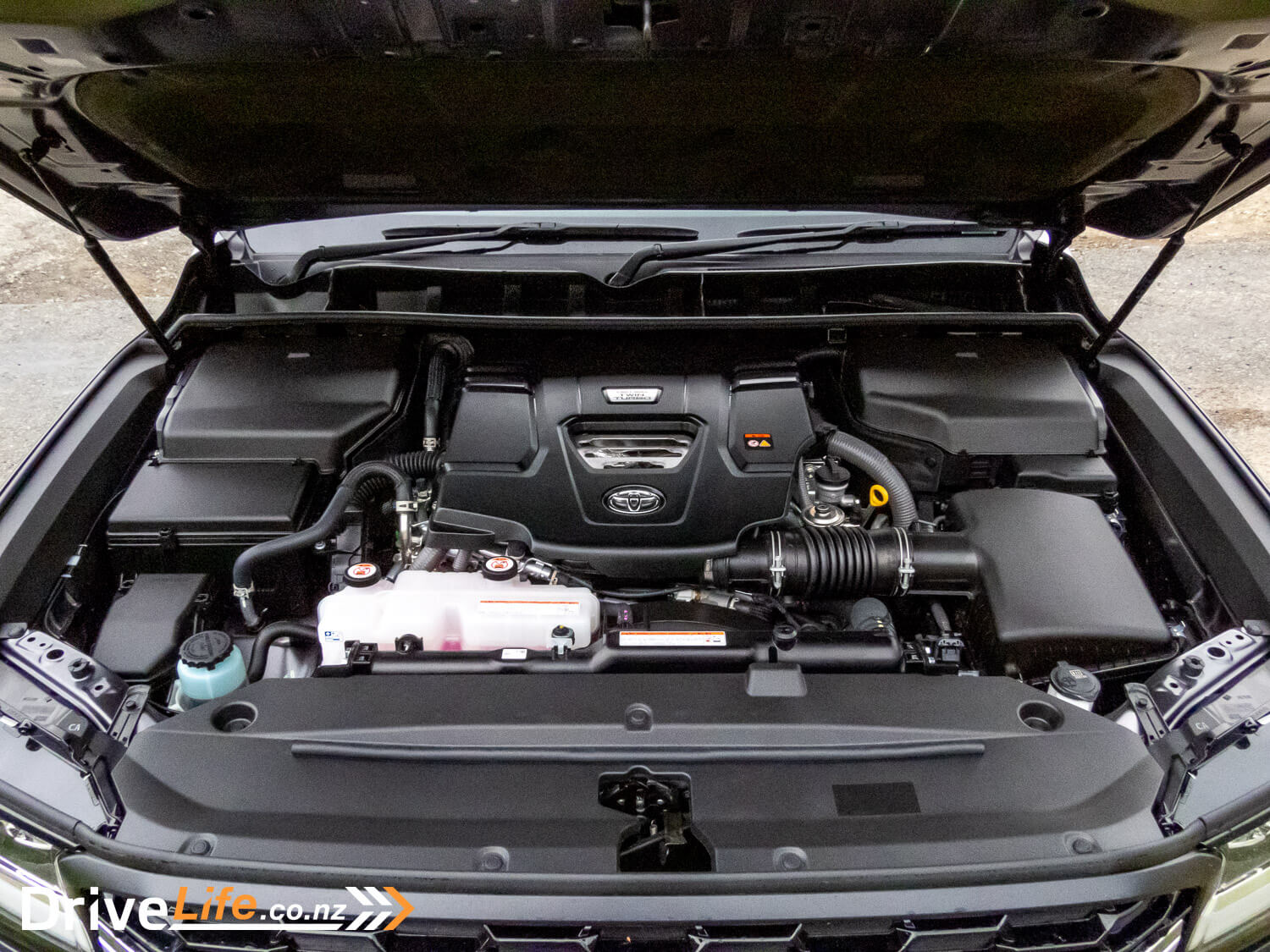
So, it’s obvious that the Land Cruiser 300’s new engine has some big boots to fill over the outgoing V8. On paper, it definitely ticked that box. The engine, called the F33A-FTV, outputs 227kW of power and 700Nm of torque, a 27kW and 50Nm increase over the outgoing V8. The engine is paired with a 10-speed automatic transmission, powering the wheels via full time four-wheel-drive.
Although devout 200 series fans may be skeptical, this new engine is excellent.
With 700Nm on-tap, and being available nice and low in the rev-range (1600-2600rpm), this 2.6 tonne barge can boogie. Put your foot down, and the Land Cruiser will confidently whisk you up to speed with a consistent push. There’s barely any turbo-lag either, as you accelerate from any speed limit. Passing manoeuvres were a breeze.
It’s also exceptionally well refined. The turbodiesel is whisper-quiet at highway speeds, and shows no signs of exertion when you push the limit.
The 10-speed transmission has no trouble managing the masses of torque from the V6. It shifts seamlessly and holds gears appropriately when accelerating. Despite all of those gearbox cogs, the transmission never hunted for gears, which is a total credit to Toyota’s fantastic gearbox tuning.
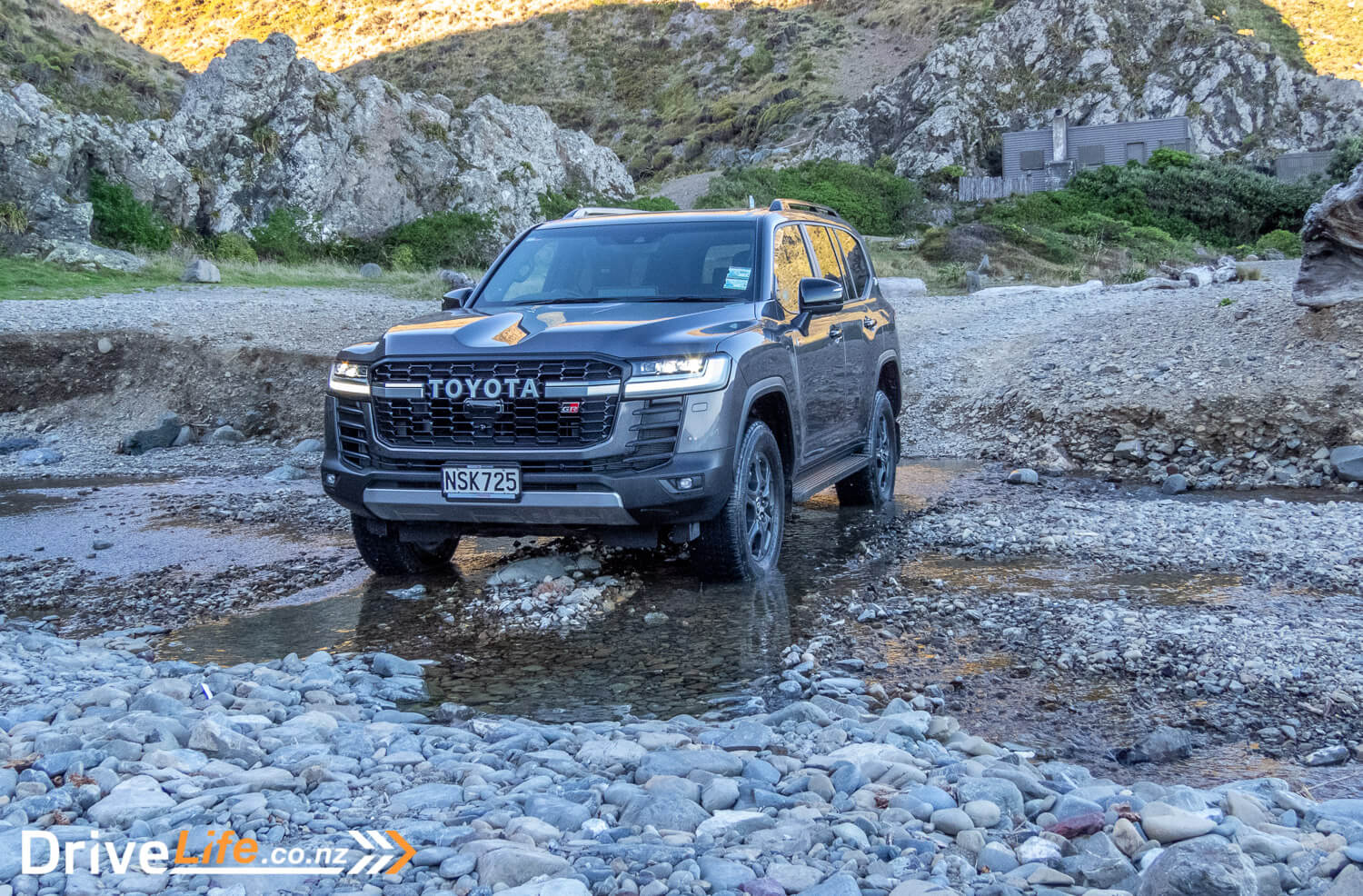
Of course, better fuel economy is another advantage from the downsized engine. In older V8 Land Cruisers, you could almost watch the fuel gauge fall in real time given how thirsty they were.
During our test, we achieved a fuel consumption of 11.3L per 100kms, which included some less-than-sensitive throttle inputs during our time off-road. It’s not a bad result when you consider that Toyota’s claimed figure is 10.2L per 100kms. Although a layperson mightn’t think that’s a good result, they should be aware V8 Land Cruisers commonly scored north of 14L per 100km in the real world. You’ll also be able to go far on a tank. Toyota has equipped the Land Cruiser 300 with a reserve fuel tank, which gives the 300 series a 110L total capacity (80L + 30L).
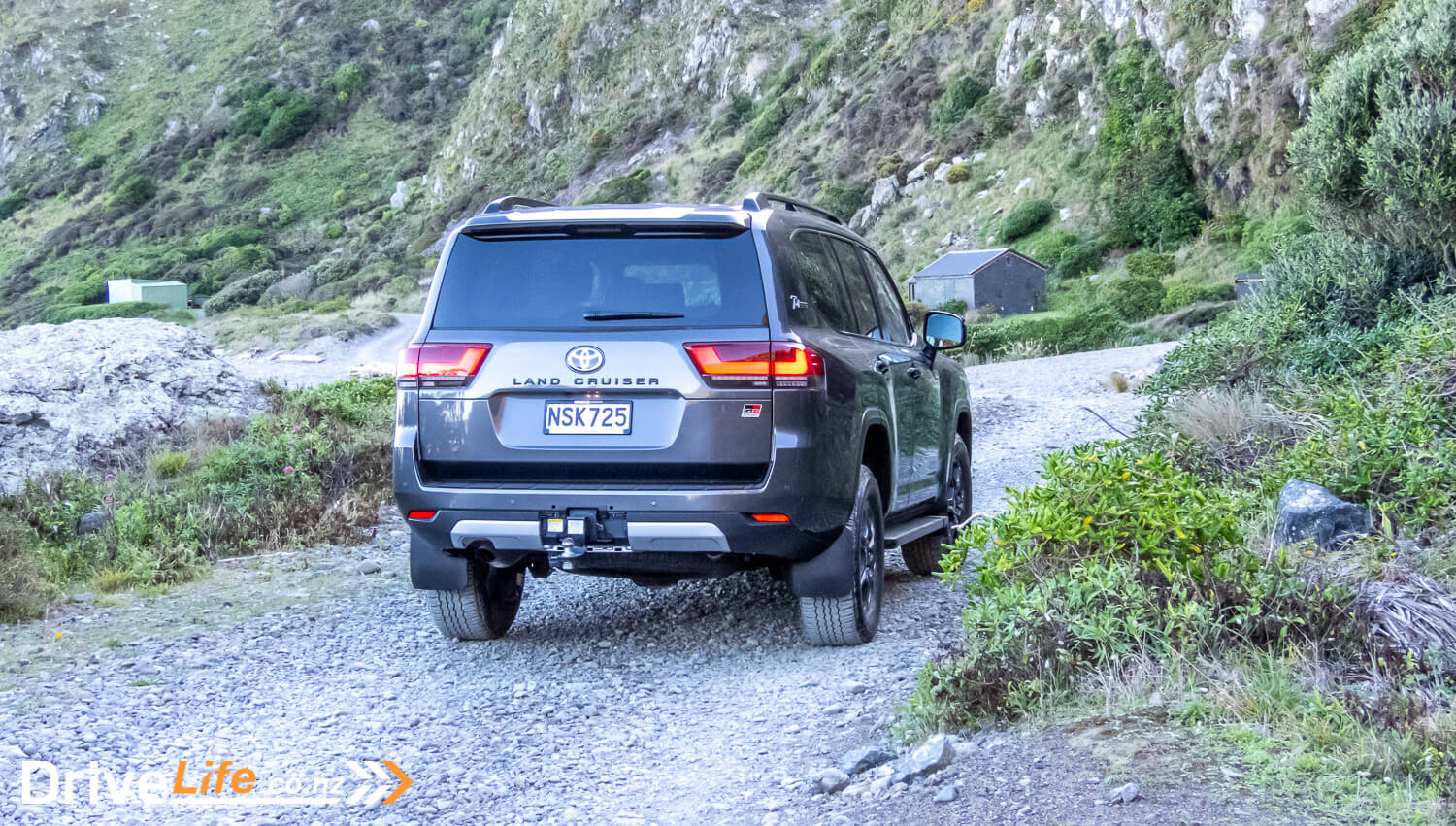
So, the engine and gearbox are solid, and the fuel economy has improved. How does it actually drive?
On the tarmac, the Land Cruiser has impressive body control for its large stature. I expected the Land Cruiser to handle like a brick, but its composure was impressive for a large SUV.
Sure, it mightn’t be as polished as some uni-bodied European SUVs that ride around on air-suspension, but the Land Cruiser does a good job concealing its tough body-on-frame underpinnings.
GR Sport variants are equipped with adaptive suspension, giving it further capability on and off-road. For the road, there are five different driving modes, being Comfort, Eco, Normal, Sport S and Sport S+.
Sport S and Sport S + modes (nope, that’s not a typo) do appear to help the mighty Cruiser manage its mass better. In faster corners, the nose pushes out less making it easier to hold a tidier line. Although, I expect you’ll want to spend most of your time in Comfort mode. This mode softens all the inputs, and allows you to enjoy the ride rather than nip at corners.
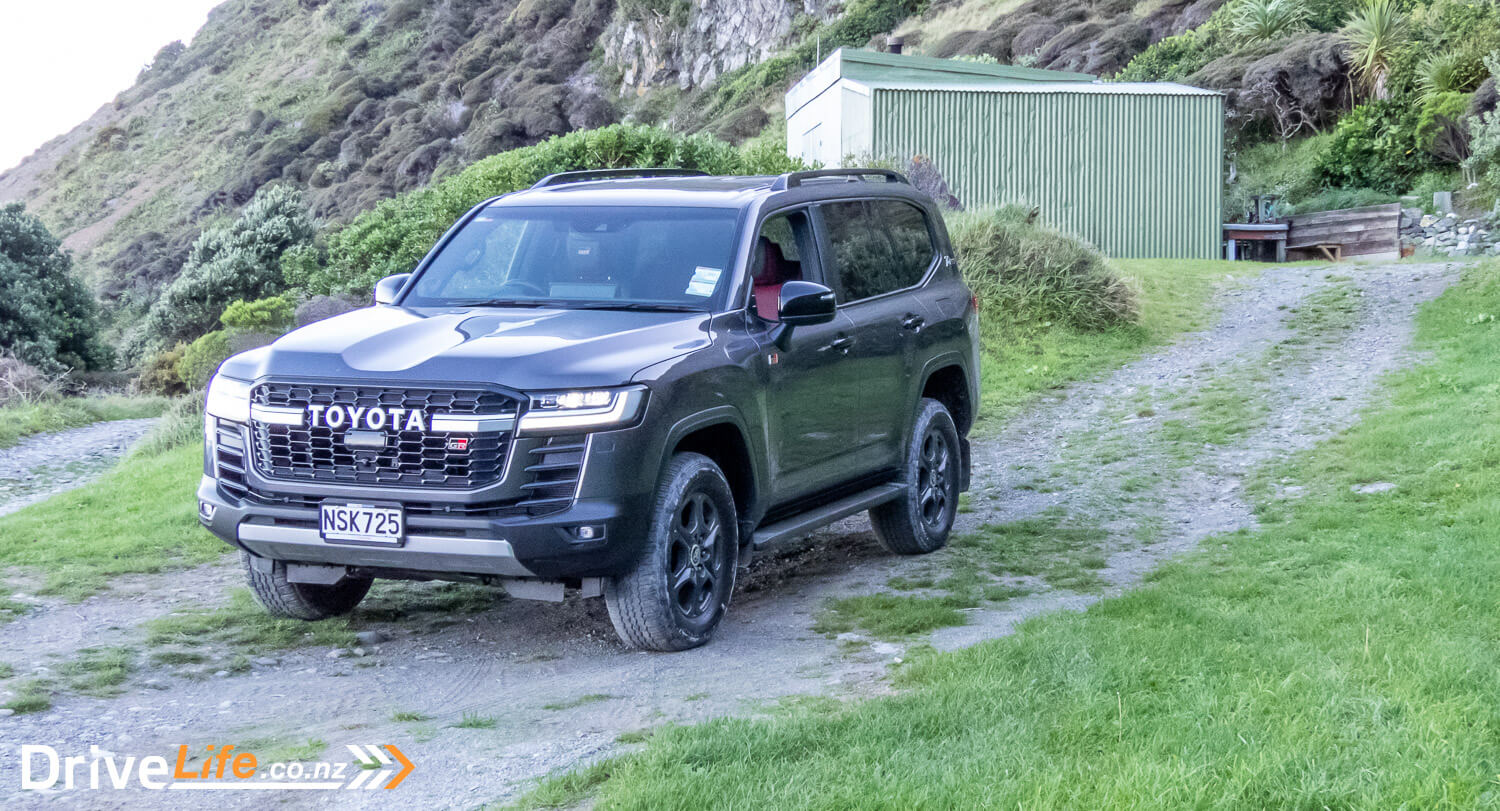
The GR Sport also features Toyota’s E-KDSS system, which stands for Electronic-Kinetic Dynamic Suspension System. The outgoing 200 series had a version of this, but it was mechanical. E-KDSS responds considerably quicker. When on the road, E-KDSS allows the Land Cruiser to firm up each end of the sway bars to reduce body roll.
Even though Toyota’s engineering wizardry can keep the Land Cruiser from rolling sideways, you’ll still notice the Land Cruiser’s high-riding mass when you floor it from a stand-still. You’ll feel the bodyweight slosh backwards over the rear wheels, in a manner that the boaties among us might recognise.
As for steering, the Land Cruiser uses a hydraulic steering rack rather than a full electric one. It has a decent weight to it when cruising around, and it’s light enough at low speeds (although, an electric one might be lighter). The steering inputs are quite blunt. If anything, many drivers will appreciate the low sensitivity given the Land Cruiser’s mass. I certainly did.
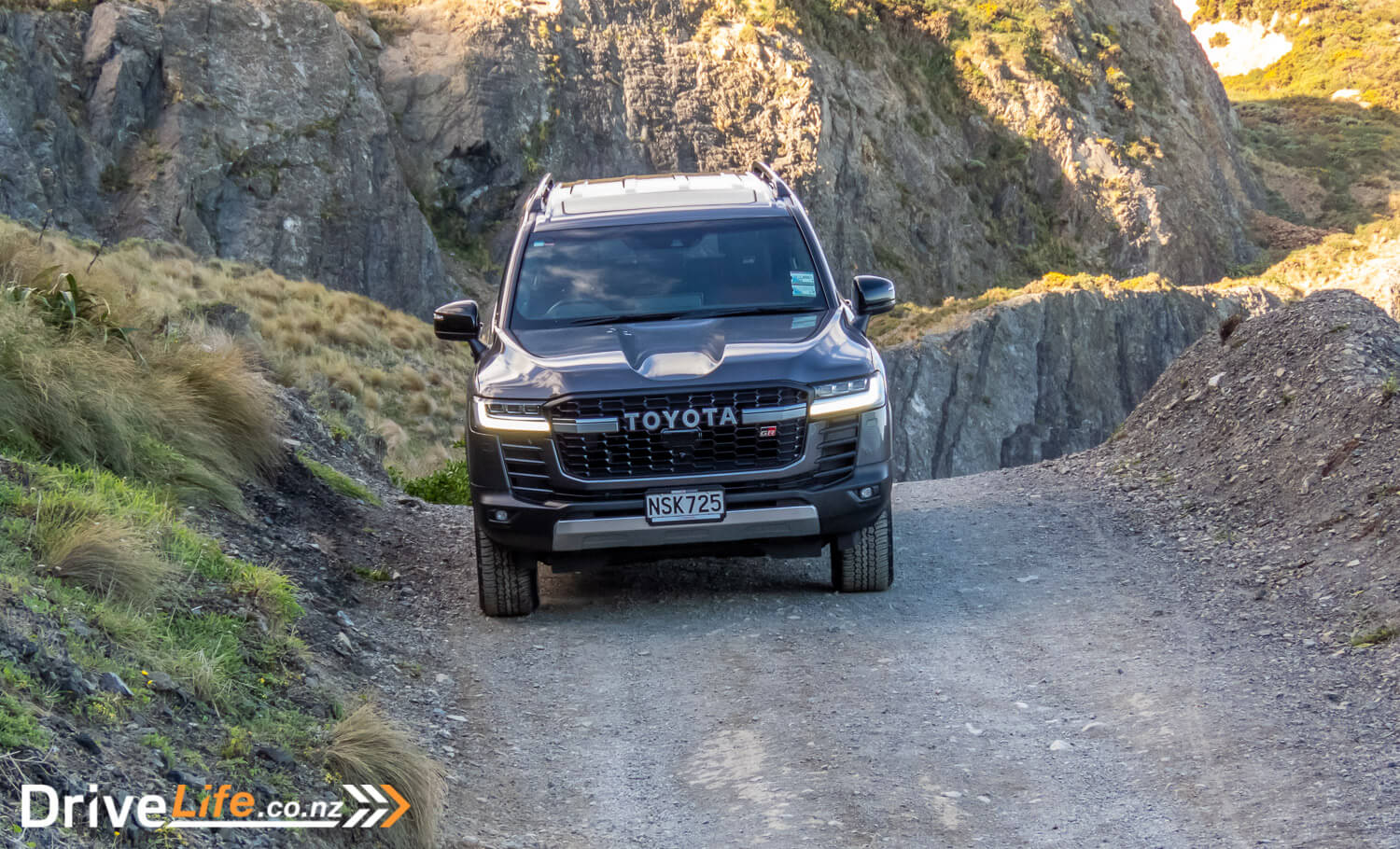
Anyway, should we get to the bit you’re really here for? How does the Land Cruiser 300 perform off-road?
First, we should mention the specs. As standard, the Land Cruiser range gets a variety of off-roading software. This includes Crawl Control (like an off-road cruise control), Hill Descent Control and a trick Multi-Terrain Select system, which has five different modes of Dirt, Sand, Mud, Deep Snow and Auto.
Each mode has different settings for the torque flows, monitoring the suspension settings and the system can work the brakes to mitigate wheel slip and traction issues. In terms of hardware, a centre limited-slip Torsen differential is standard.
One of the reasons the GR Sport is the most anticipated 300 series Land Cruiser is due to the additional off-roading hardware it gains over the VX and VX Limited.
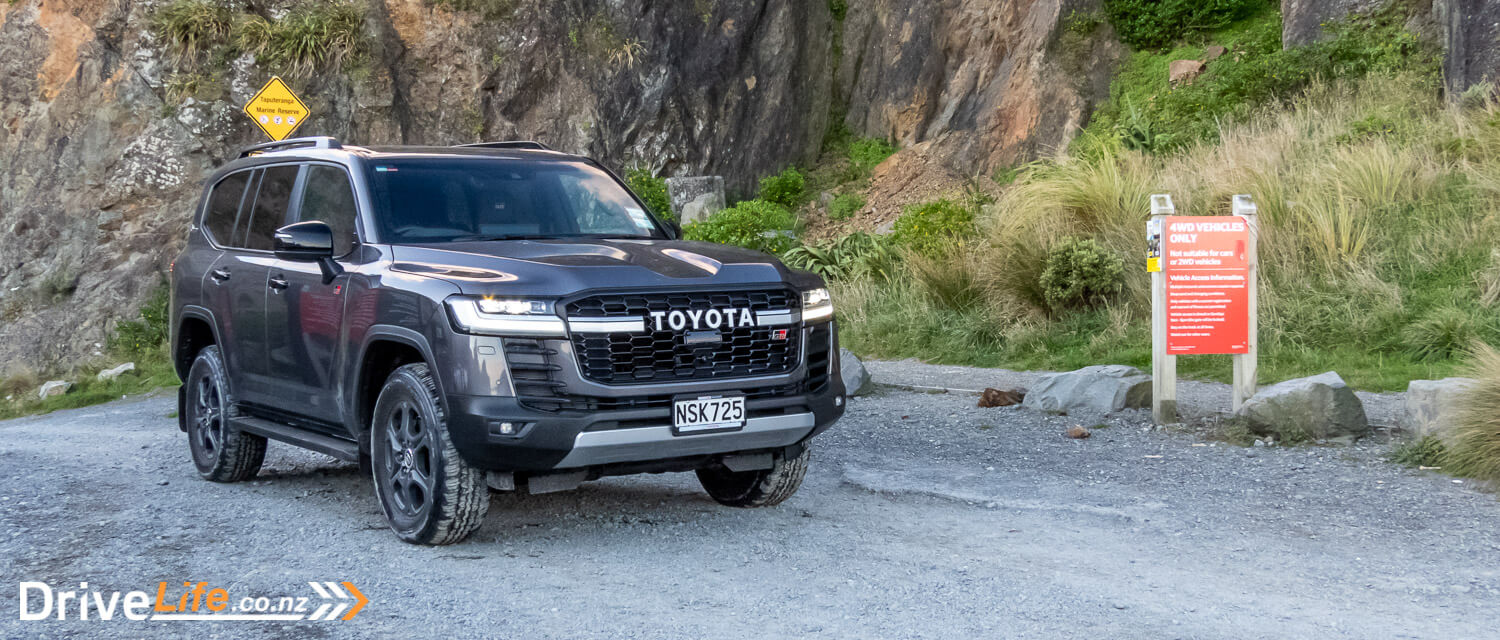
The GR Sport gains front and rear locking differentials, and its adaptive suspension links in with the Multi-Terrain Select system, which adjusts the settings to suit the terrain. The GR Sport also has the advantage of E-KDSS, which we mentioned earlier in this section. When off-road, E-KDSS allows the GR-Sport to detach the front and rear sway bars to improve wheel articulation.
Nobody will question that a VX or VX Limited will be able to go places many SUVs cannot. The GR Sport, on the other hand, is the Land Cruiser that brought a gun to a knife fight.
With all of the extra gear, the Land Cruiser GR Sport will go further than most of our capabilities will allow. Although, I wanted to experience it first-hand, meaning a trip to Red Rocks was on the cards.
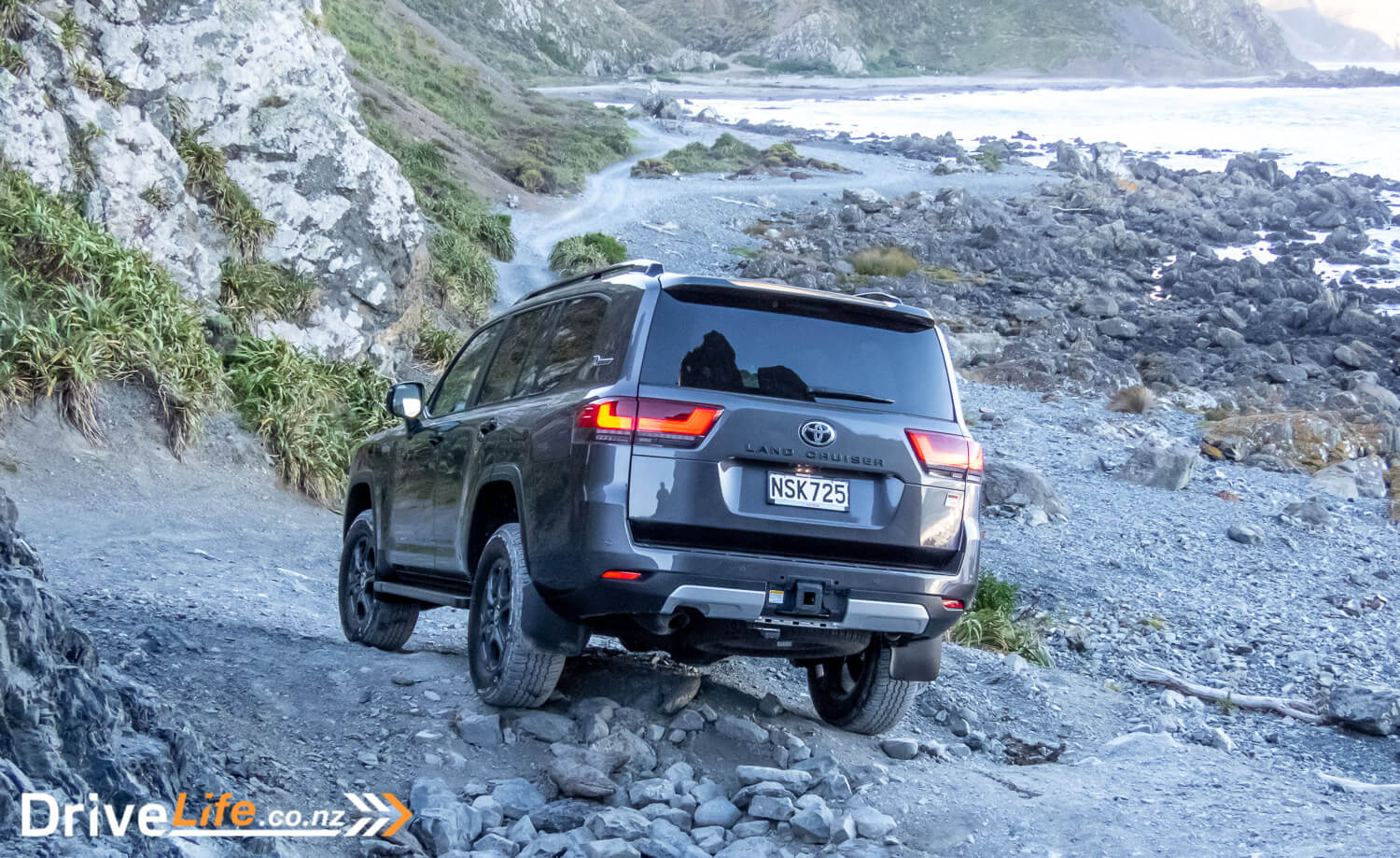
For those that haven’t experienced it, Red Rocks does have some challenging terrain. There are soft sand dunes, rocky sections, and also the Devil’s Gate. I expected none of it to phase the mighty Land Cruiser, but I wasn’t prepared for how easily it dispensed with the difficult sections.
When I last came out to Red Rocks, I was in the Nissan Navara Warrior. The Warrior is an impressive machine in its own right, but when it came to the softer stuff, plenty of steering input was needed to keep the Warrior from fishtailing.
By comparison, tackling the soft stuff in the Land Cruiser was like drawing a straight-line with a ruler. It was completely effortless. Meanwhile, the adaptive suspension kept the Land Cruiser completely planted at all times, particularly so over loose surfaces.
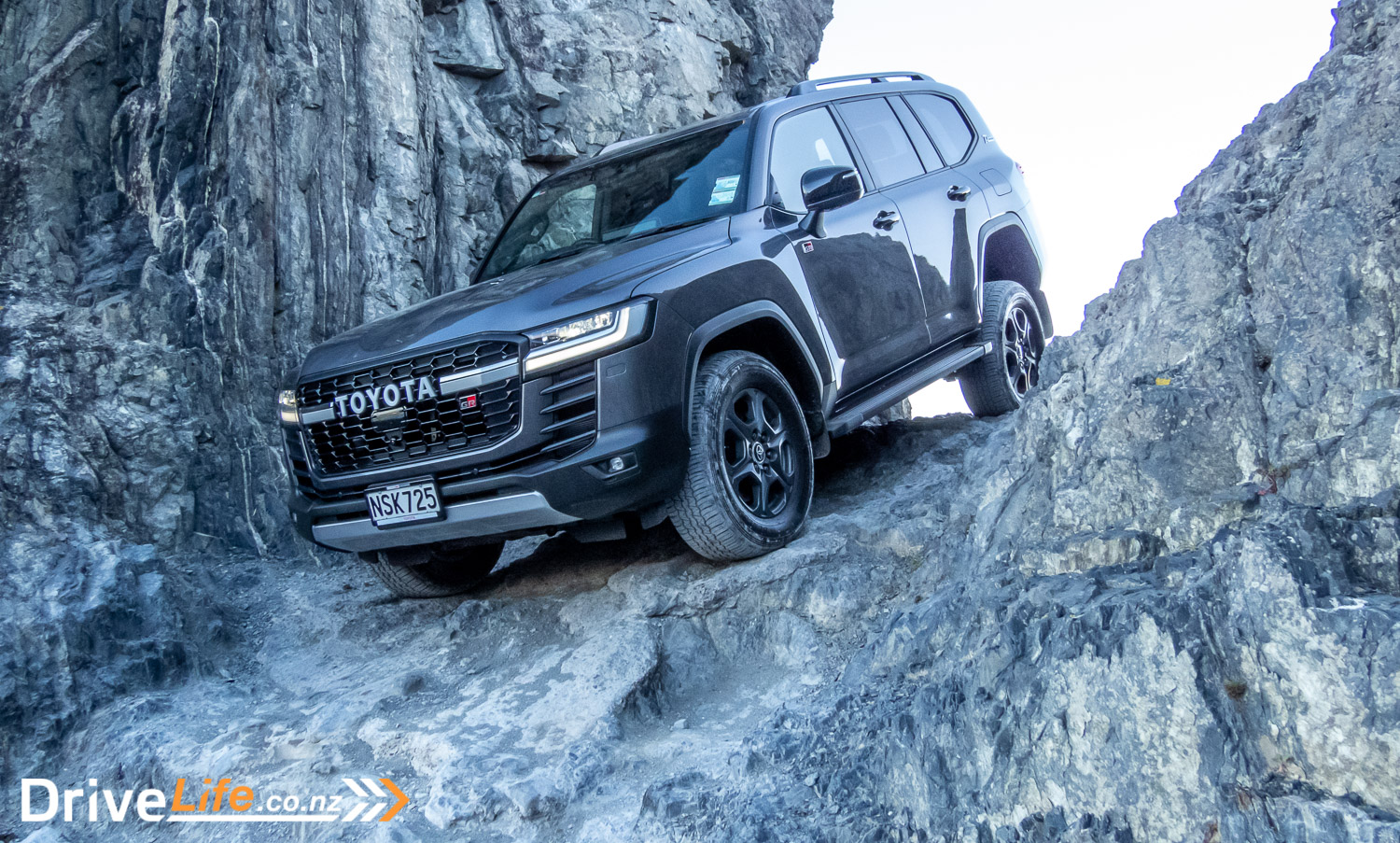
I couldn’t resist the photo opportunity upon arriving at Devil’s Gate. I did think tyre traction might be an issue here. All Land Cruisers come standard on Dunlop AT30 all-terrain tyres, which are solid dual-purpose tyres, but nothing quite like a tyre dedicated for the job. However, after locking the differentials, the Land Cruiser simply waltzed on-through like it was no-body’s business.
The journey around the south-coast was virtually drama-free. While I did second guess a few manoeuvres over some larger rocks, the exterior camera views proved useful for ensuring you had the proper clearances. The below-the-body camera also simulates where the wheels are, allowing you to see hidden obstacles.
The Land Cruiser’s 235mm ground clearance is more than plenty. Although, given how capable the GR Sport is, many enthusiasts are likely to throw on a larger set of tyres, to give it the appropriate clearance for tougher terrain.
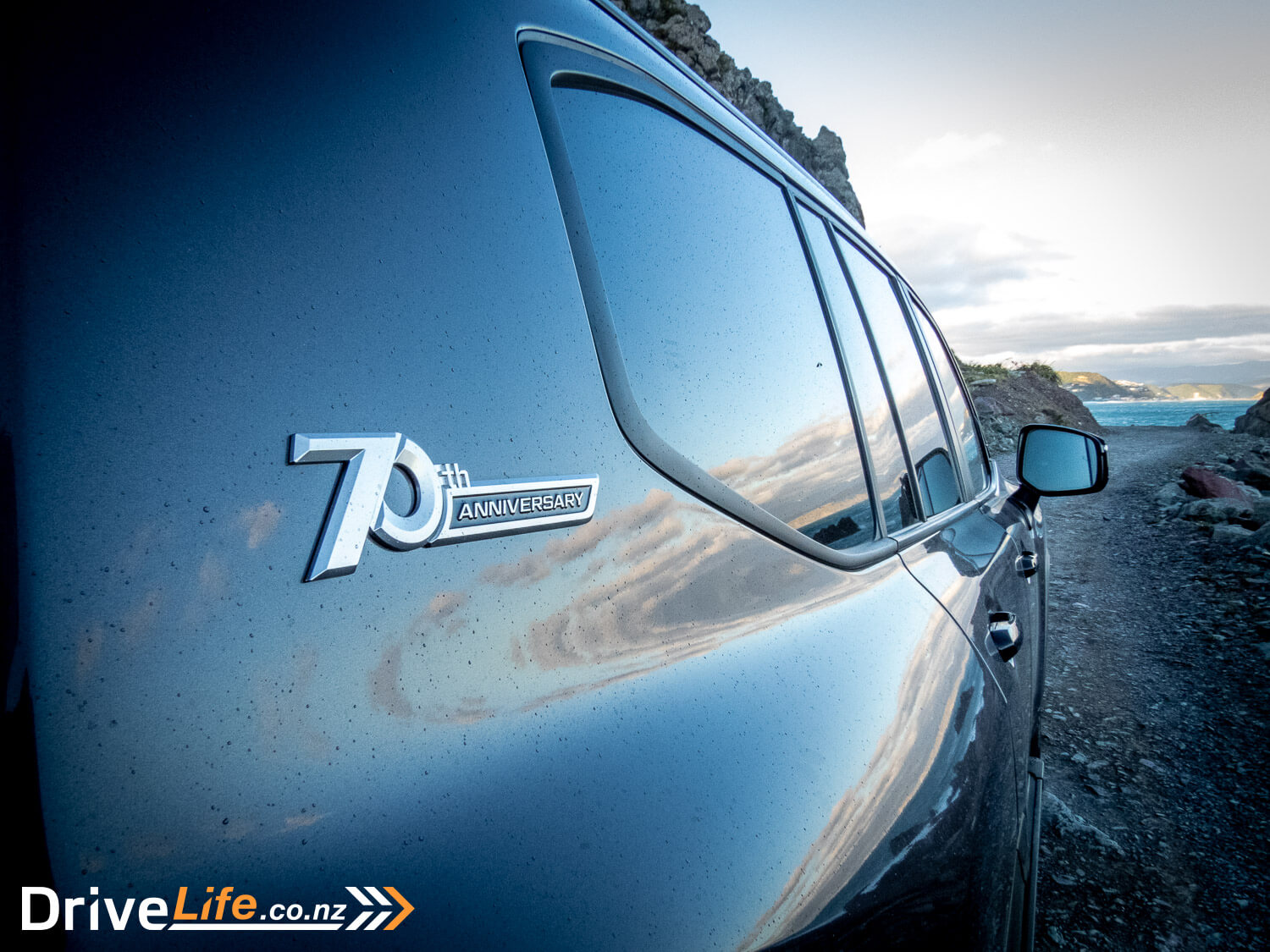
As is the norm for 2022, the Land Cruiser 300 is awash with the latest safety tech. The Land Cruiser 300 gains Toyota Safety Sense technology package, adding a considerable list of safety features over the 200 series.
My past experience would dictate that Toyota’s Safety Sense package is effective, albeit a tad sensitive at times. In the Land Cruiser 300, this sensitivity is noticeable with the adaptive cruise control and the lane keep assistance.
The adaptive cruise control is quite reactive to changing traffic states. For example, I found it quite lurchy when another driver crossed in front of me on the motorway. Otherwise, the software is pretty good overall.
The other minor gripe is with the lane keep assistance software. Toyota has a feature called Yaw control which will gently apply the brakes if it determines you’ve strayed too far beyond the line. Being of great height, whenever Yaw control activated at higher speeds, the Land Cruiser would develop a somewhat uncomfortable slew. Although many SUVs have a system similar to this, the Land Cruiser’s version could do with some tweaking.
Fortunately, Toyota does make the lane keep assistance easy to switch-off. Just remember to hold down the button the steering wheel once you’ve started the car, and you’ll be sweet as.
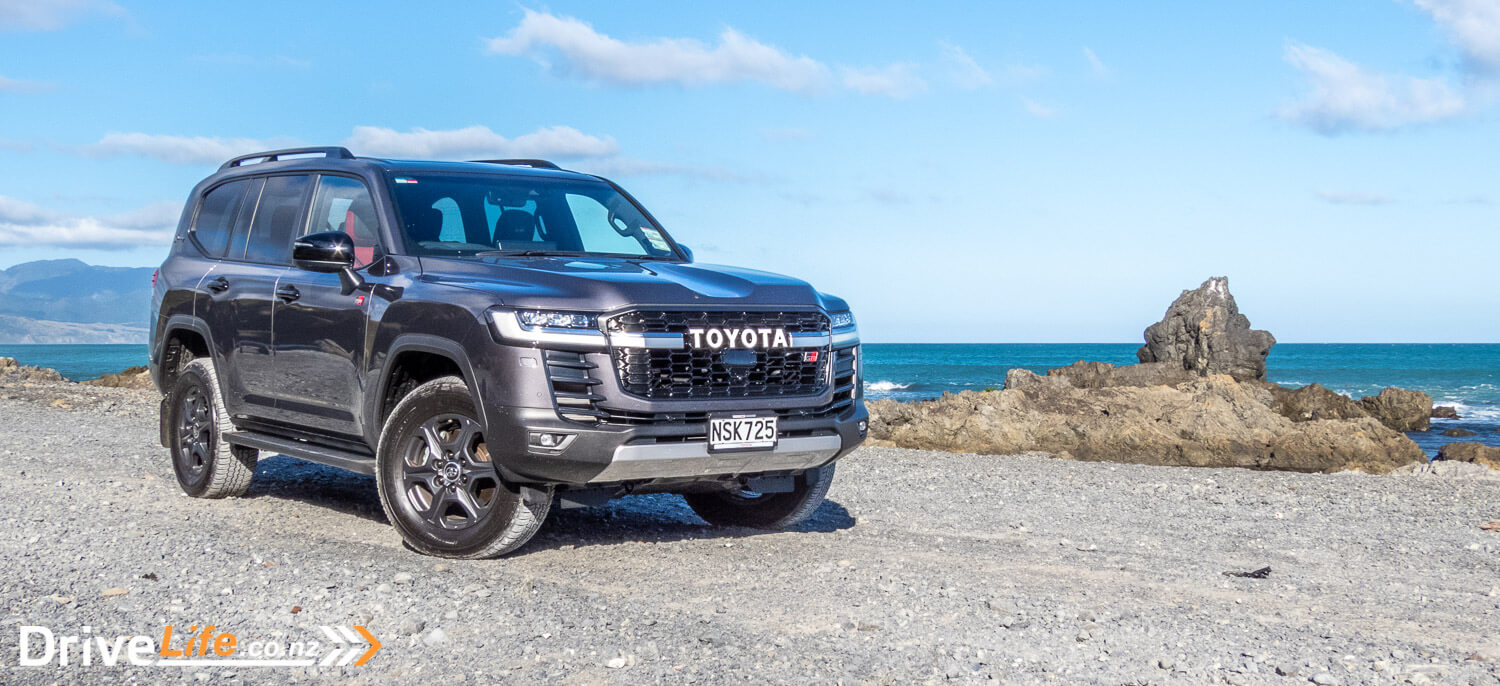
2022 Toyota Land Cruiser 300 GR Sport Specifications
| Vehicle Type | SUV |
| Starting Price | $147,990 |
| Price as Tested | $147,990 |
| Engine | 3.3-litre twin-turbo 6-cylinder diesel |
| Power, Torque kW/Nm | 227/700 |
| Transmission | 10-speed Automatic |
| Spare Wheel | Full-size alloy |
| Kerb Weight, Kg | 2,630 |
| Length x Width x Height mm | 4995 x 1990 x 1945 |
| Boot Space / Cargo Capacity, Litres (seats up/seats down) | 1131 (second-row in place) 2052 (second row down) |
| Fuel tank capacity, Litres | 80 + 30 |
| Fuel Economy, L/100km | Advertised Spec – Combined – 10.2 Real-World Test – Combined – 11.3 Low Usage: 0-6 / Medium Usage 6-12 / High Usage 12+ |
| Towing Capacity Kg, unbraked/braked | 750/3500 |
| Turning circle Metres | 11.8 Small: 6-10m / Medium 10-12m / Large 12m+ |
| Warranty | 5-year warranty 5-years roadside assistance 5-years WOF coverage 5 years (or 60,000km) capped price servicing |
| Safety information | ANCAP Rating – 5 stars GR Sport not yet tested. Rightcar.govt.nz – 5 Stars – NSK725 |
Have you enjoyed this review? Be sure to join our monthly email newsletter list so you don’t miss a single car review!


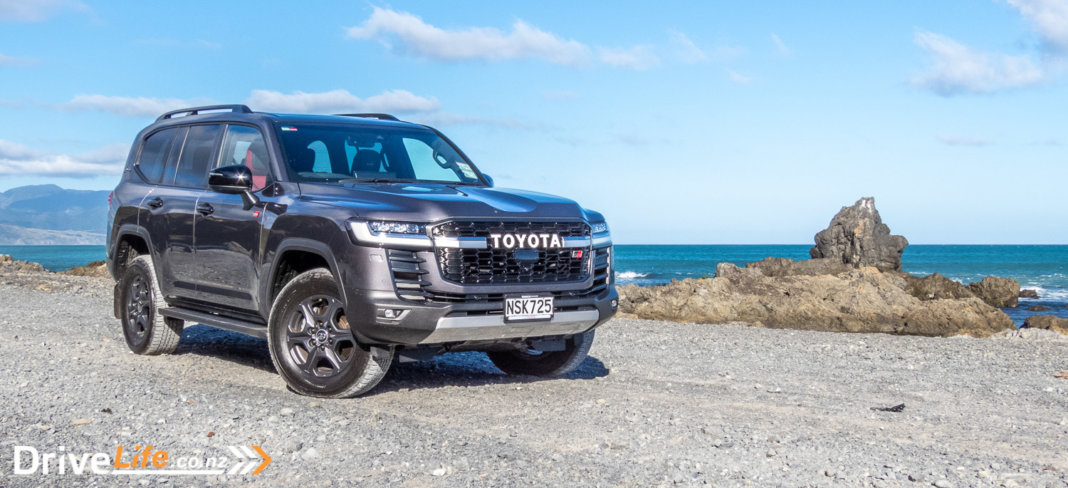
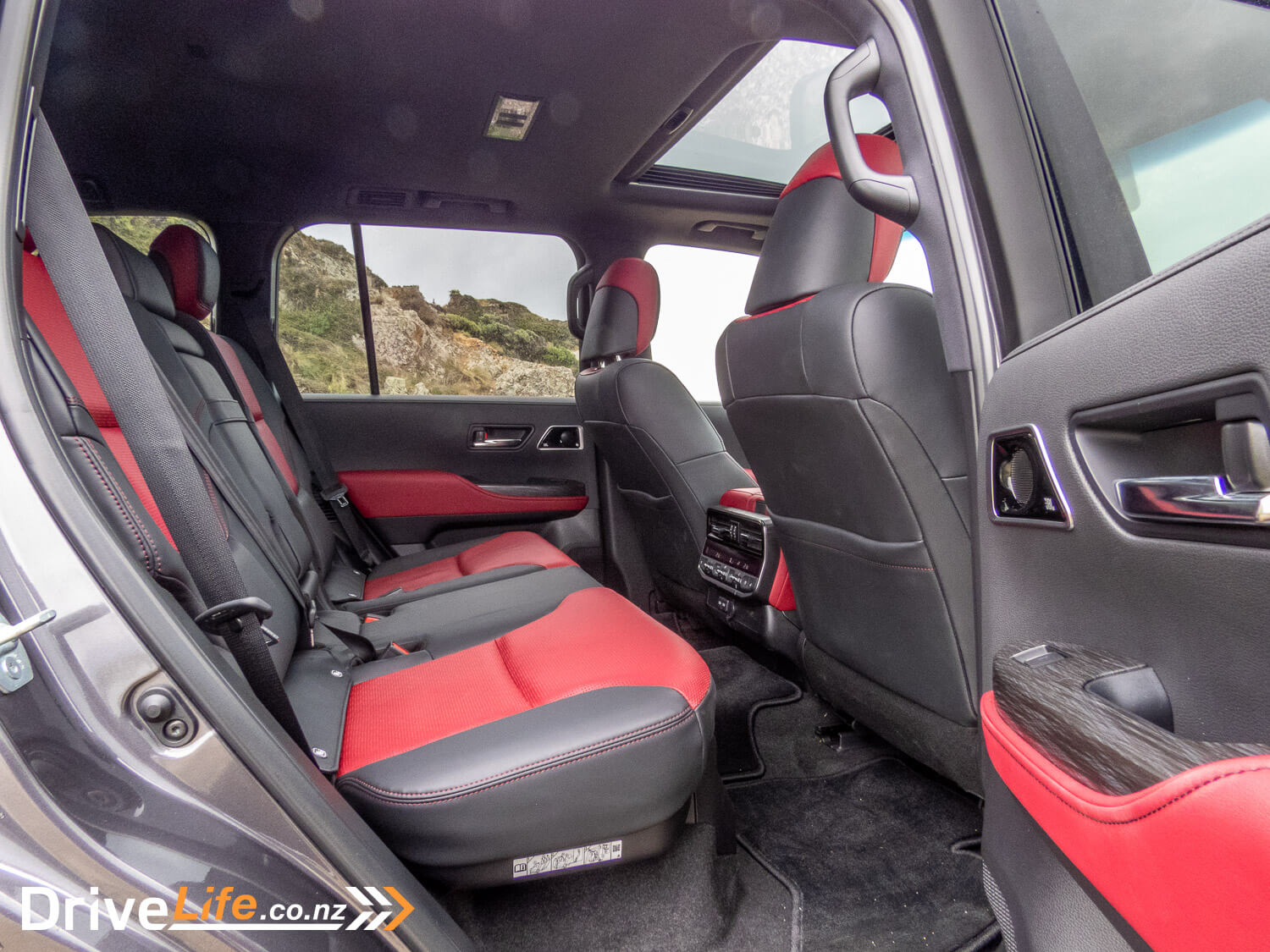
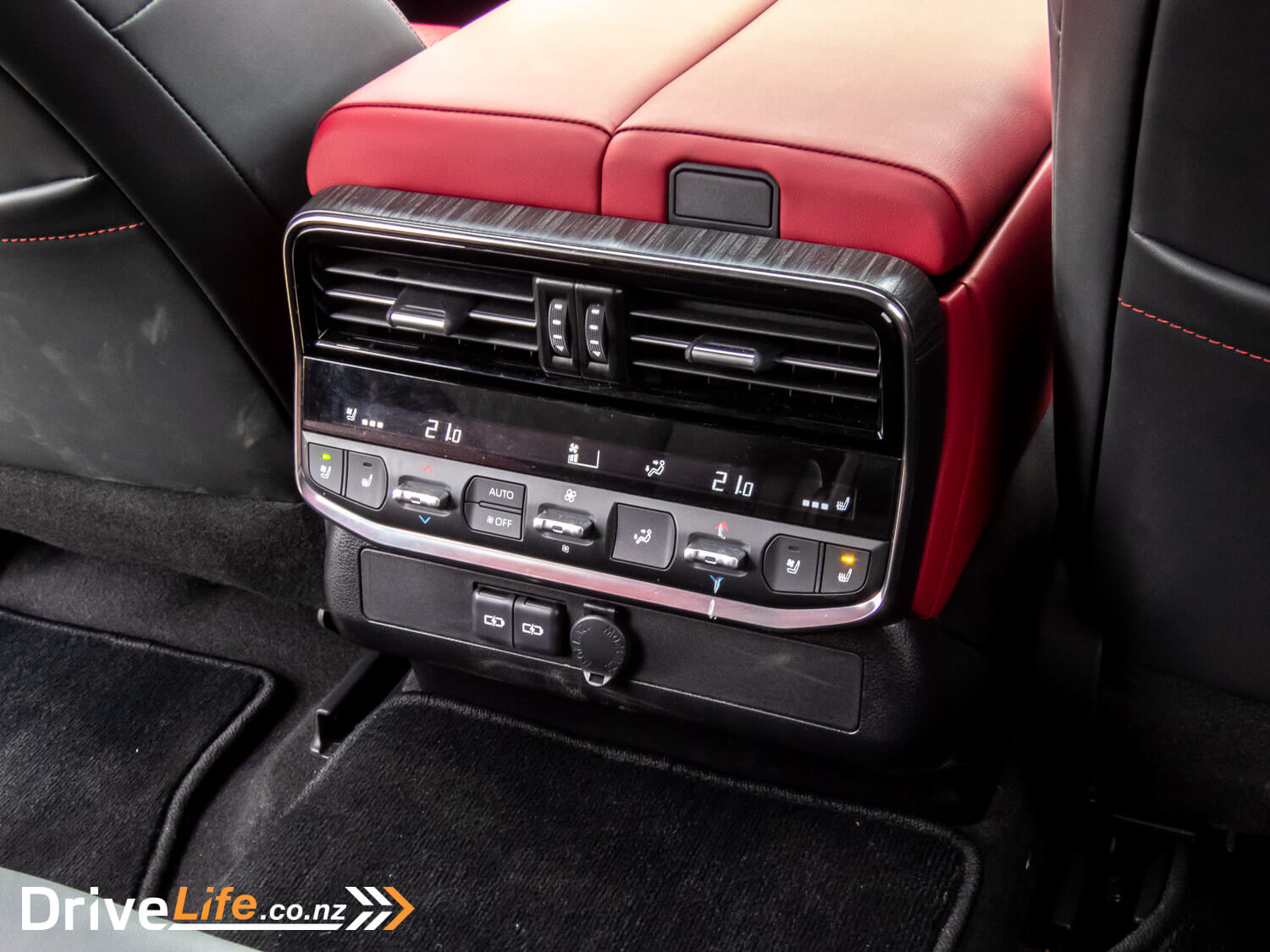
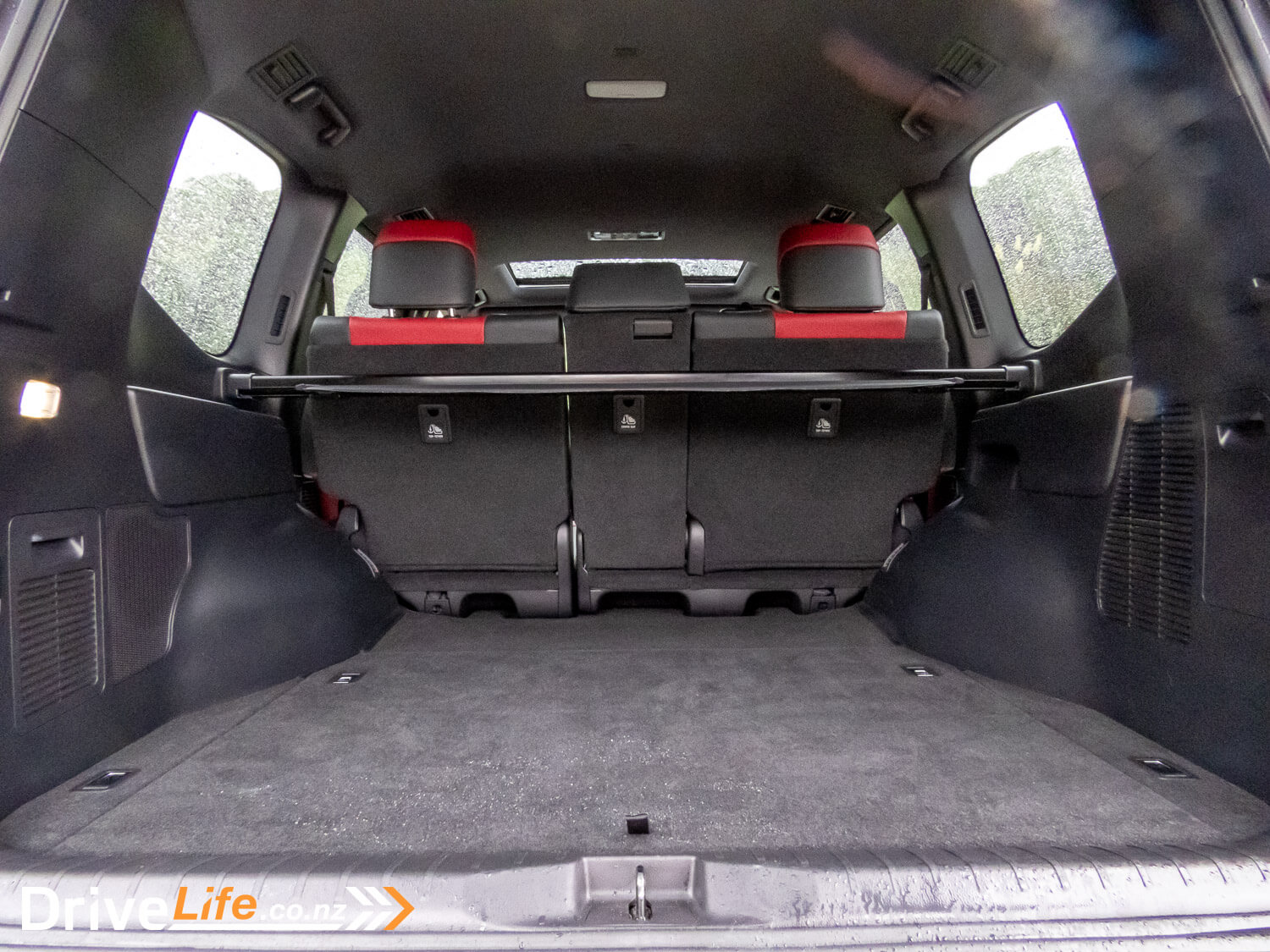
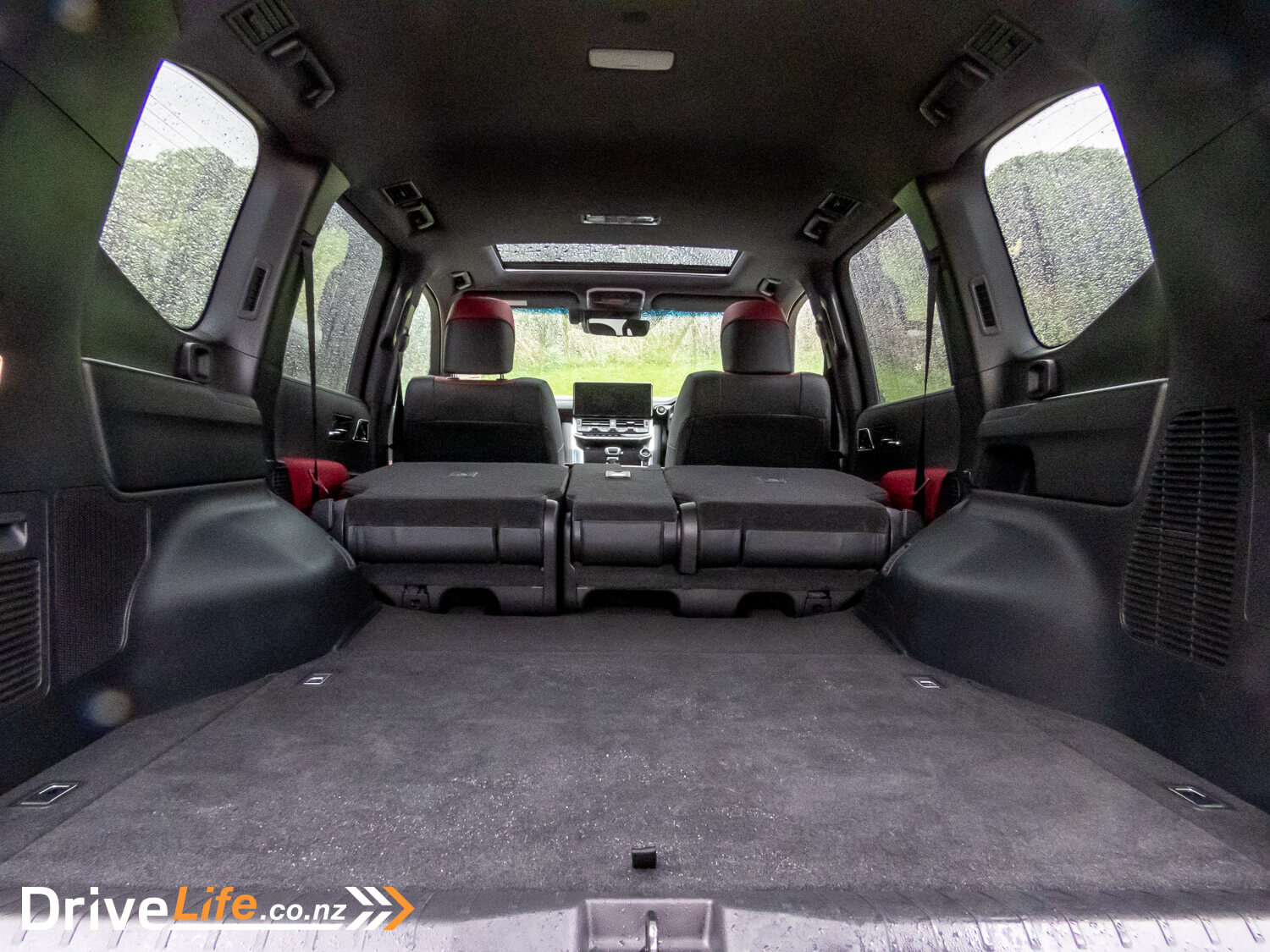
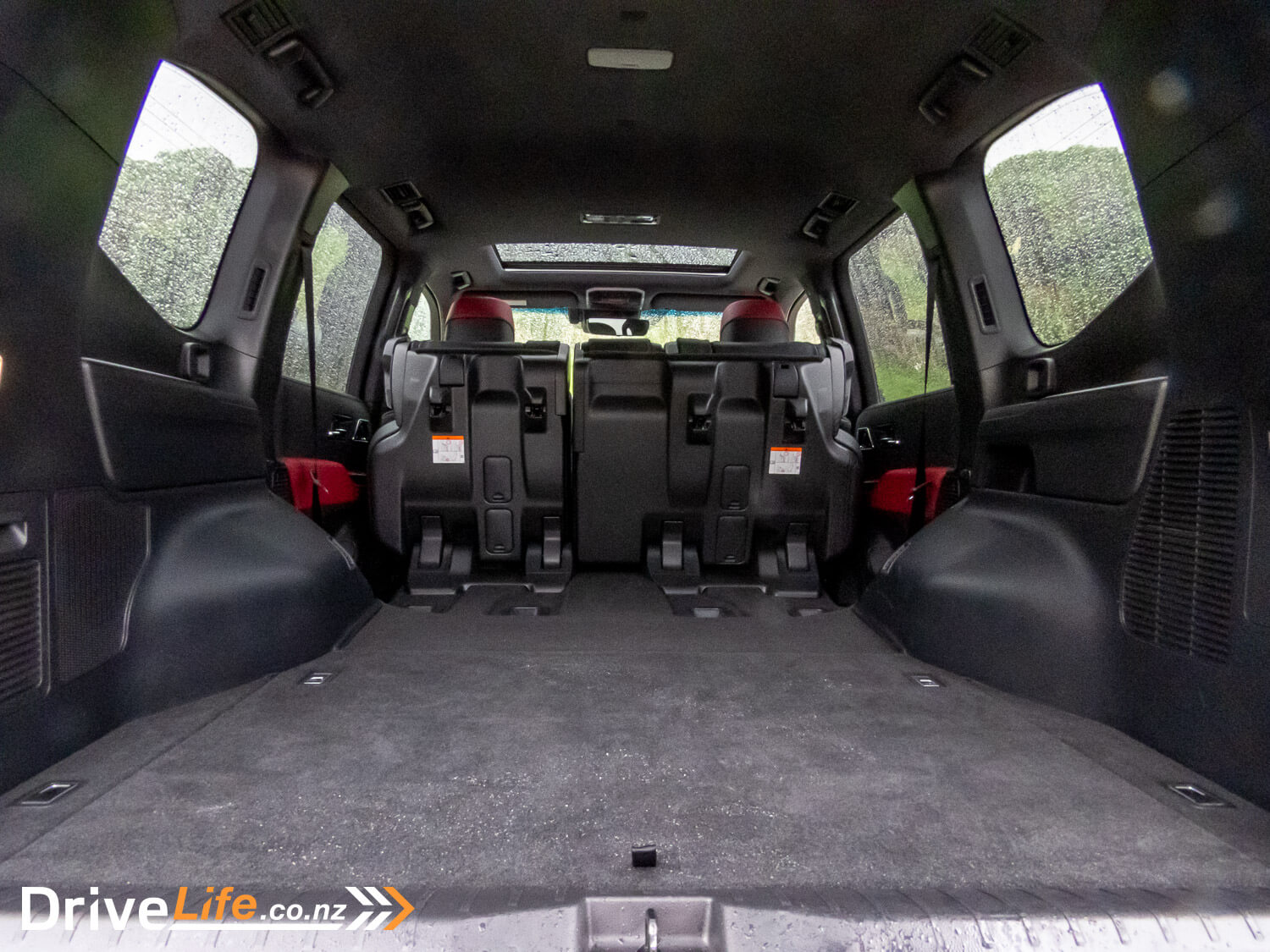
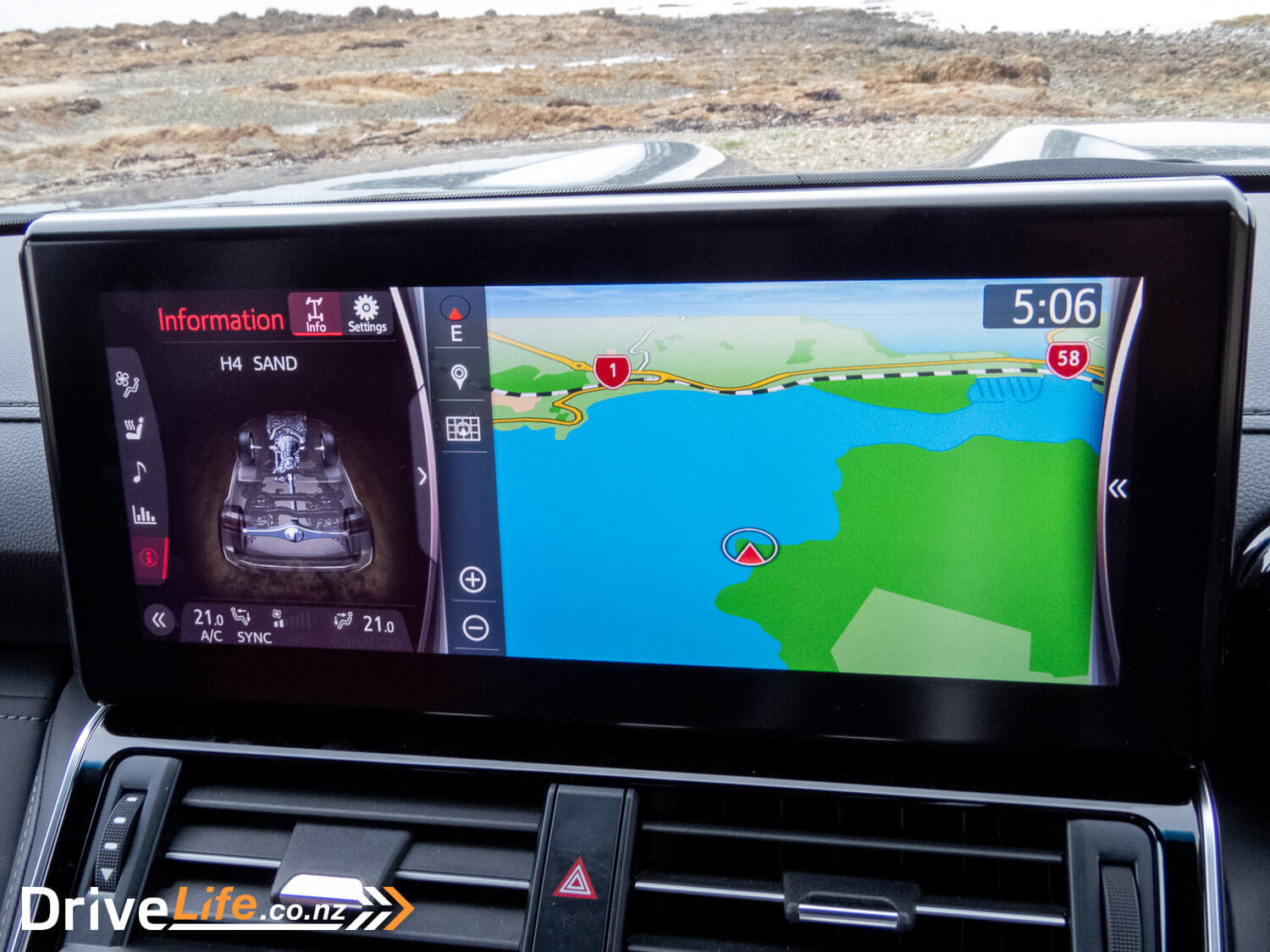
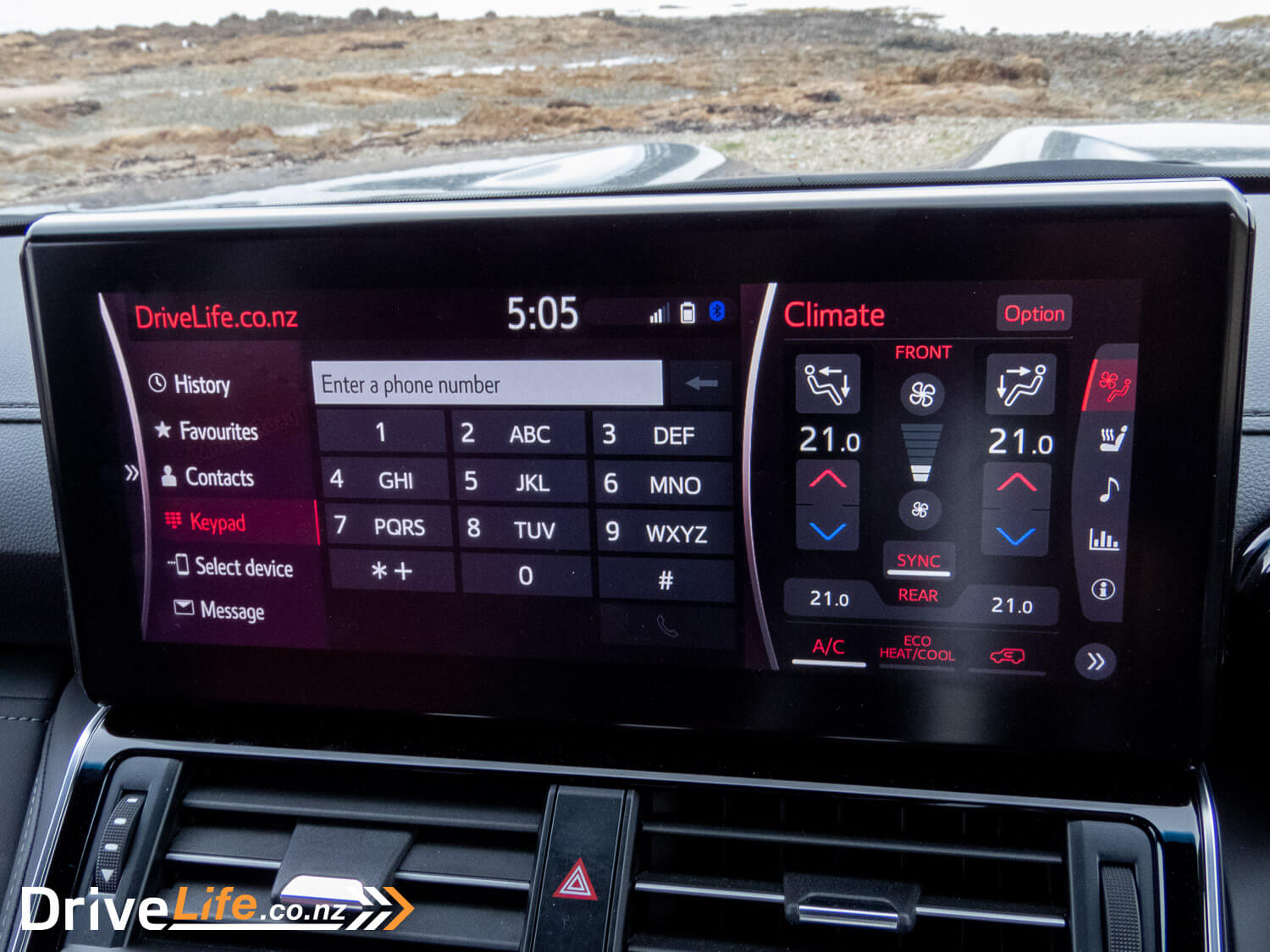
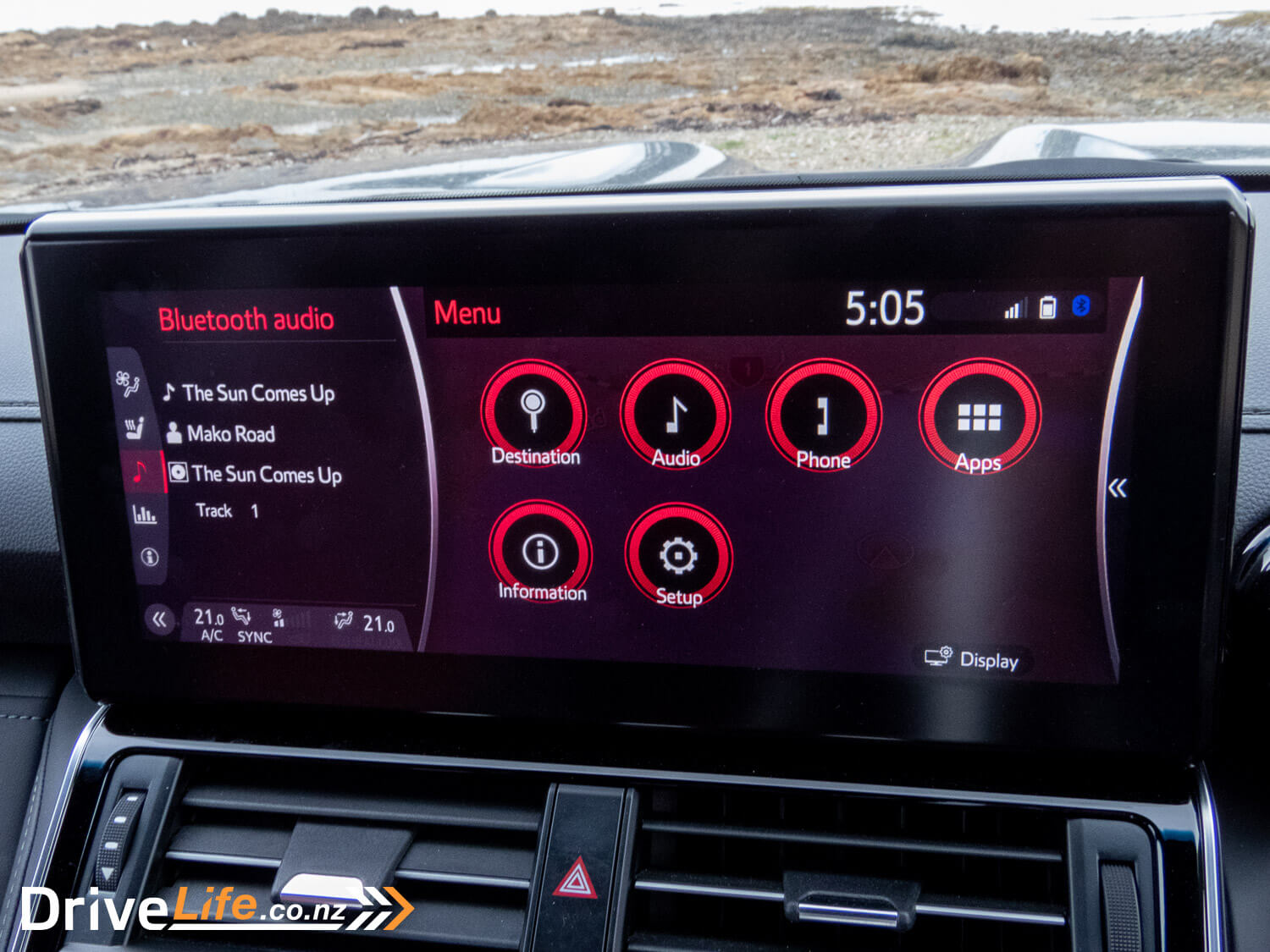
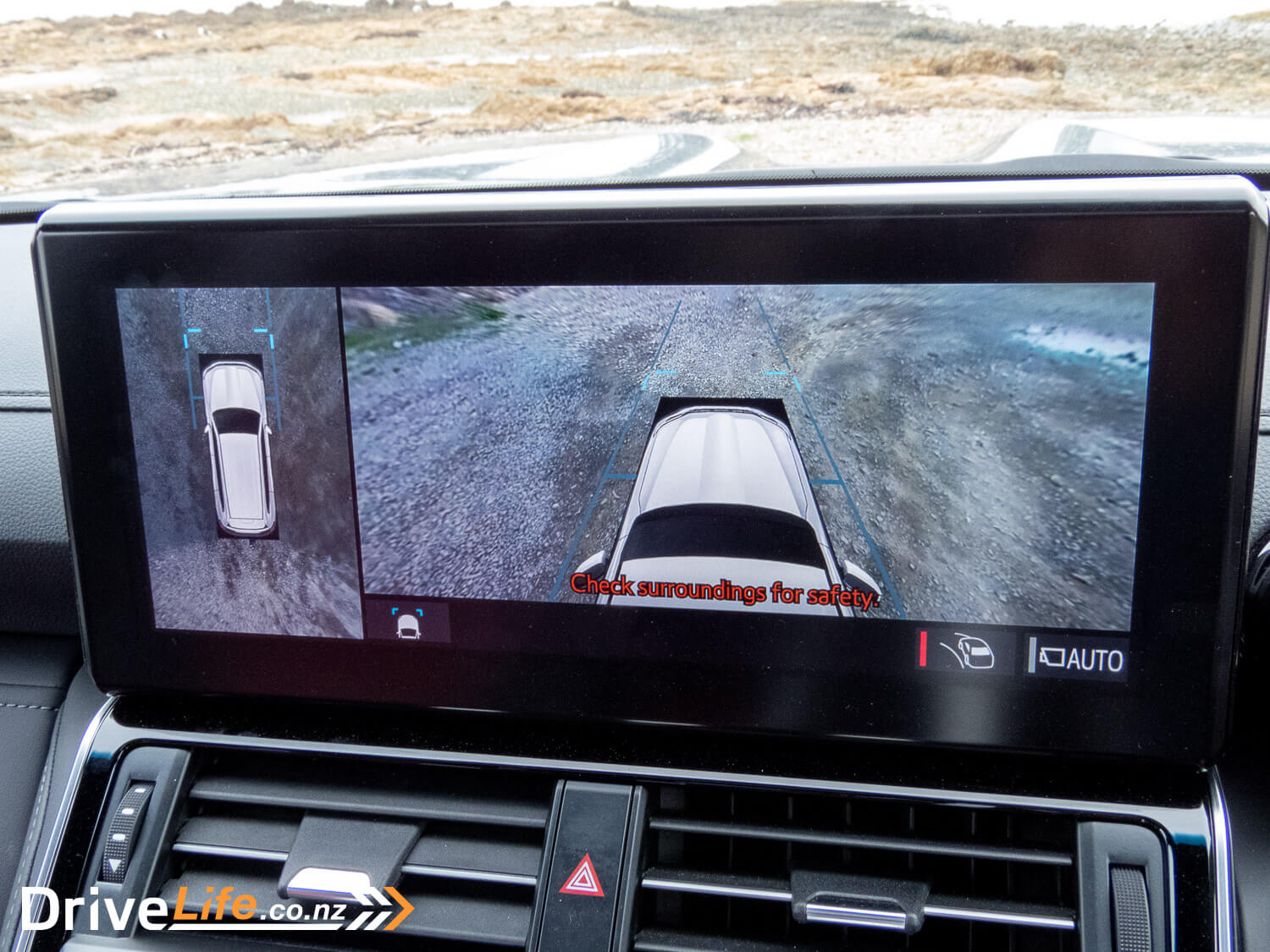
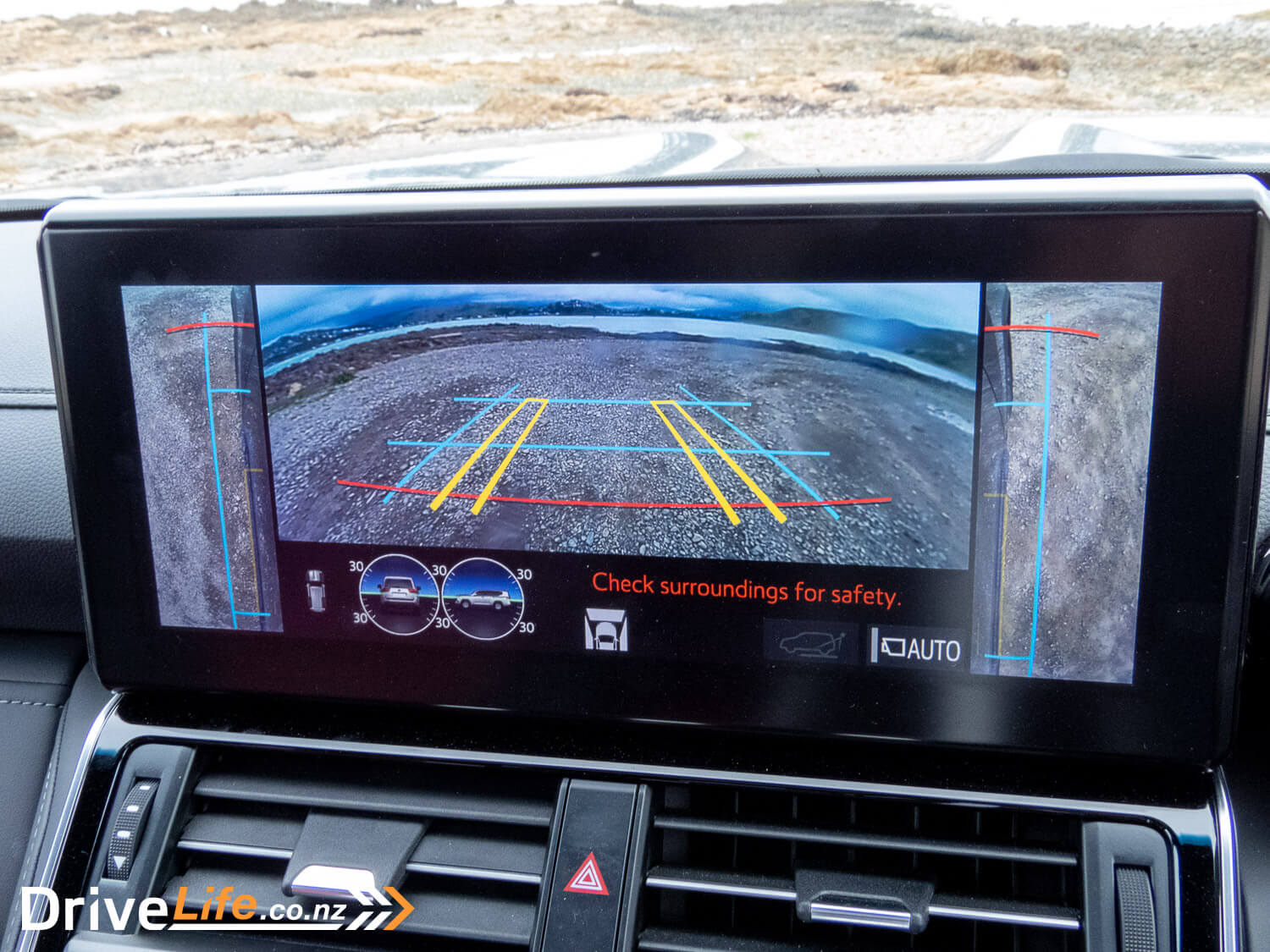
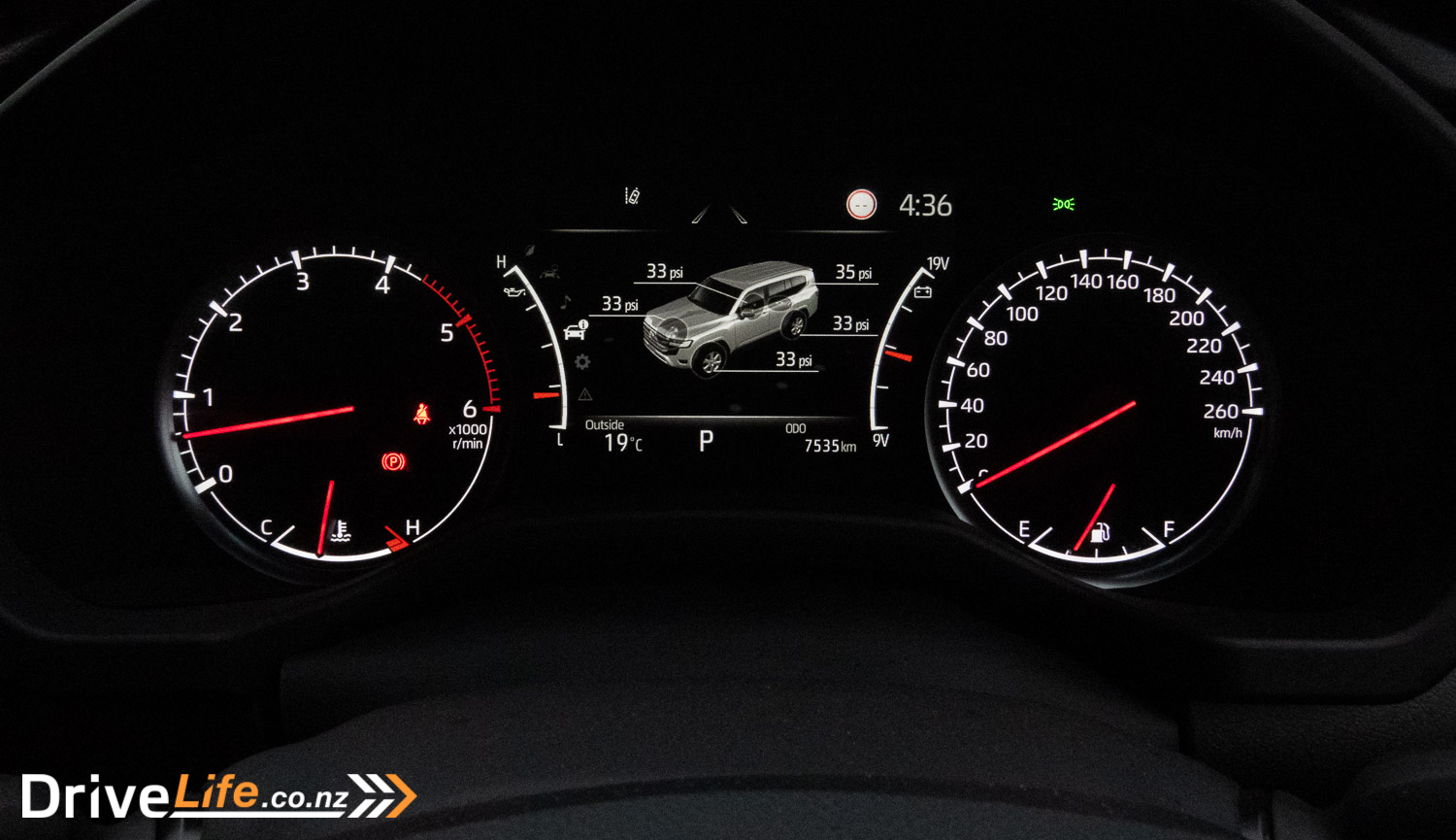
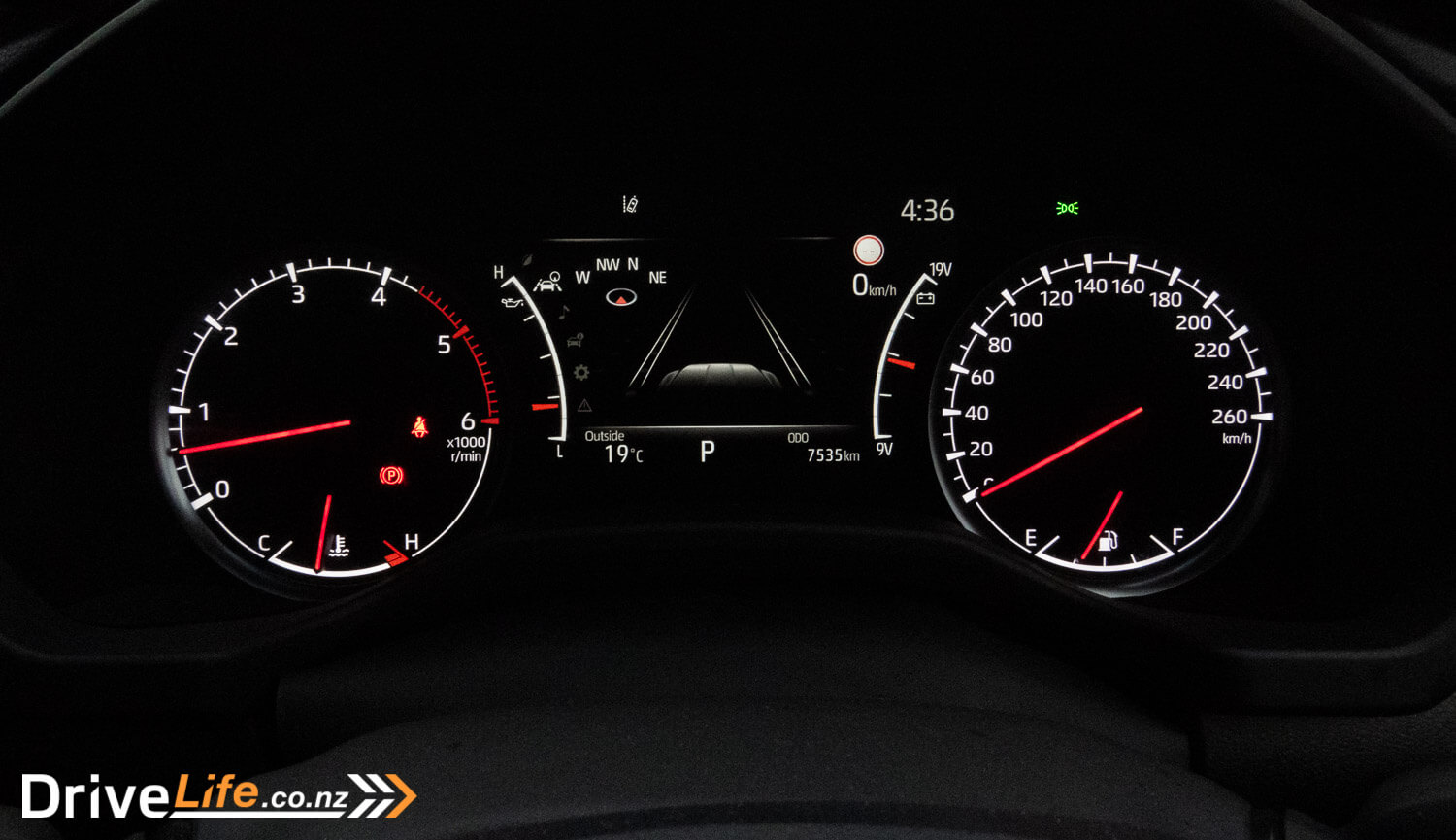






That’s really is a good car